11.5 Ellipse
Definition
An ellipse is the set of all points in a plane, the sum of whose distances from two fixed points in the plane is a constant. The two fixed points are called the foci (plural of ‘focus‘) of the ellipse (Fig10.20). We can also express it as an ellipse is the locus of a point which moves in a plane such that its distance from a fixed point (i.e. focus) is a constant ratio from a fixed line (i.e. directrix). This ratio is called eccentricity and is denoted by \(e\). For an ellipse \(0<e<1\).
Note: The constant which is the sum of the distances of a point on the ellipse from the two fixed points is always greater than the distance between the two fixed points.
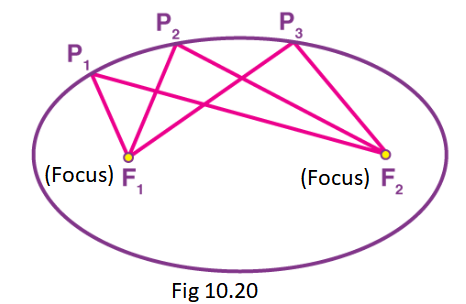
The above figure represents an ellipse such that \(P_1 F_1+P_1 F_2=P_2 F_1+P_2 F_2=P_3 F_1+P_3 F_2\) is a constant.
The mid point of the line segment joining the foci is called the centre of the ellipse. The line segment through the foci of the ellipse is called the major axis and the line segment through the centre and perpendicular to the major axis is called the minor axis. The end points of the major axis are called the vertices of the ellipse(Fig 10.21).
The mid point of the line segment joining the foci is called the centre of the ellipse. The line segment through the foci of the ellipse is called the major axis and the lines AB, CD, F1F2 denote the length of the major axis by \(2 a\), the length of the minor axis by \(2 b\) and the distance between the foci by \(2 c\) respectively. Thus, the length of the semi major axis is \(a\) and semi-minor axis is \(b\) (Fig10.22).
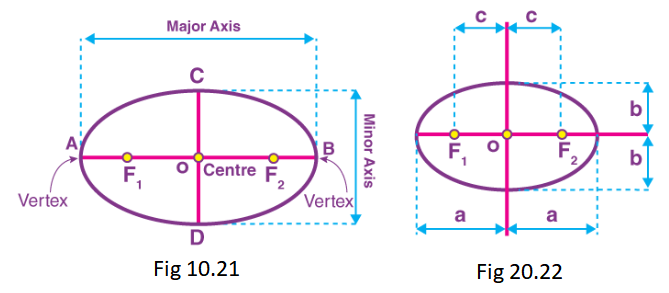
Relationship between semi-major axis, semi-minor axis and the distance of the focus from the centre of the ellipse (Fig 10.23).
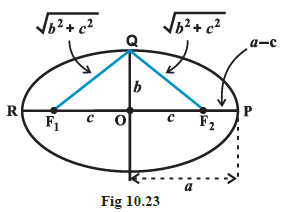
Take a point \(P\) at one end of the major axis. Sum of the distances of the point \(P\) to the foci is \(F _1 P + F _2 P = F _1 O + OP + F _2 P\)
(Since, \(F _1 P = F _1 O + OP\) )
\(
=c+a+a-c=2 a
\)
Take a point \(Q\) at one end of the minor axis.
Sum of the distances from the point \(Q\) to the foci is
\(
F _1 Q + F _2 Q =\sqrt{b^2+c^2}+\sqrt{b^2+c^2}=2 \sqrt{b^2+c^2}
\)
Since both \(P\) and \(Q\) lies on the ellipse.
By the definition of ellipse, we have
\(
2 \sqrt{b^2+c^2}=2 a \text {, i.e., } \quad a=\sqrt{b^2+c^2}
\)
\(
\text { or } \quad a^2=b^2+c^2 \text {, i.e., } c=\sqrt{a^2-b^2}
\)
Eccentricity
Definition: The eccentricity of an ellipse is the ratio of the distances from the centre of the ellipse to one of the foci and to one of the vertices of the ellipse (eccentricity is denoted by \(e\) ) i.e., \(e=\frac{c}{a}\).
Then since the focus is at a distance of \(c\) from the centre, in terms of the eccentricity the focus is at a distance of \(a e\) from the centre.
Standard equations of an ellipse
The equation of an ellipse is simplest if the centre of the ellipse is at the origin and the foci are on the \(x\)-axis or \(y\)-axis. The two such possible orientations are shown in Fig 10.24. We will derive the equation for the ellipse shown above in Fig 10.24 (a) with foci on the \(x\)-axis.
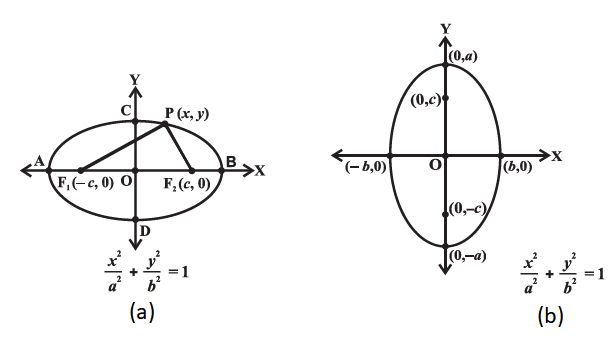
Let \(F_1\) and \(F_2\) be the foci and \(O\) be the mid-point of the line segment \(F_1 F_2\). Let \(O\) be the origin and the line from \(O\) through \(F_2\) be the positive \(x\)-axis and that through \(F _1\) as the negative \(x\)-axis. Let, the line through \(O\) perpendicular to the \(x\)-axis be the \(y\)-axis. Let the coordinates of \(F _1\) be \((-c, 0)\) and \(F _2\) be \((c, 0)\) (Fig 10.25).
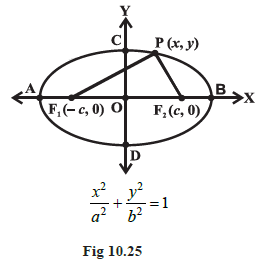
Let \(P (x, y)\) be any point on the ellipse such that the sum of the distances from \(P\) to the two foci be \(2 a\) so given
\(
PF _1+ PF _2=2 a \dots(1)
\)
Using the distance formula, we have
\(
\sqrt{(x+c)^2+y^2}+\sqrt{(x-c)^2+y^2}=2 a
\)
\(
\text { i.e., } \sqrt{(x+c)^2+y^2}=2 a-\sqrt{(x-c)^2+y^2}
\)
Squaring both sides, we get
\(
(x+c)^2+y^2=4 a^2-4 a \sqrt{(x-c)^2+y^2}+(x-c)^2+y^2
\)
which on simplification gives
\(
\sqrt{(x-c)^2+y^2}=a-\frac{c}{a} x
\)
Squaring again and simplifying, we get
\(
\frac{x^2}{a^2}+\frac{y^2}{a^2-c^2}=1
\)
\(
\text { i.e., } \quad \frac{x^2}{a^2}+\frac{y^2}{b^2}=1 \text { (Since } c^2=a^2-b^2 \text { ) }
\)
Hence any point on the ellipse satisfies
\(
\frac{x^2}{a^2}+\frac{y^2}{b^2}=1 \dots(2)
\)
Conversely, let \(P (x, y)\) satisfy the equation (2) with \(0<c<a\). Then
\(
y^2=b^2\left(1-\frac{x^2}{a^2}\right)
\)
\(
\begin{aligned}
\text { Therefore, } PF _1 & =\sqrt{(x+c)^2+y^2} \\
& =\sqrt{(x+c)^2+b^2\left(\frac{a^2-x^2}{a^2}\right)}
\end{aligned}
\)
\(
=\sqrt{(x+c)^2+\left(a^2-c^2\right)\left(\frac{a^2-x^2}{a^2}\right)}\left(\text { since } b^2=a^2-c^2\right)
\)
\(
=\sqrt{\left(a+\frac{c x}{a}\right)^2}=a+\frac{c}{a} x
\)
Similarly \(\quad PF _2=a-\frac{c}{a} x\)
Hence \(\quad PF _1+ PF _2=a+\frac{c}{a} x+a-\frac{c}{a} x=2 a \dots(3)\)
So, any point that satisfies \(\frac{x^2}{a^2}+\frac{y^2}{b^2}=1\), satisfies the geometric condition and so \(P (x, y)\) lies on the ellipse.
Hence from (2) and (3), we proved that the equation of an ellipse with centre of the origin and major axis along the \(x\)-axis is
\(
\frac{x^2}{a^2}+\frac{y^2}{b^2}=1
\)
Remarks
- From the equation of the ellipse obtained above, it follows that for every point \(P (x, y)\) on the ellipse, we have
\(
\frac{x^2}{a^2}=1-\frac{y^2}{b^2} \leq 1 \text {, i.e., } x^2 \leq a^2 \text {, so }-a \leq x \leq a \text {. }
\)
Therefore, the ellipse lies between the lines \(x=-a\) and \(x=a\) and touches these lines. Similarly, the ellipse lies between the lines \(y=-b\) and \(y=b\) and touches these lines. - Similarly, we can derive the equation of the ellipse in Fig 10.24 (b) as \(\frac{x^2}{b^2}+\frac{y^2}{a^2}=1\). These two equations are known as standard equations of the ellipses.
- Ellipse is symmetric with respect to both the coordinate axes since if \((x, y)\) is a point on the ellipse, then \((-x, y),(x,-y)\) and \((-x,-y)\) are also points on the ellipse.
- The foci always lie on the major axis. The major axis can be determined by finding the intercepts on the axes of symmetry. That is, major axis is along the \(x\)-axis if the coefficient of \(x^2\) has the larger denominator and it is along the \(y\)-axis if the coefficient of \(y^2\) has the larger denominator.
- Two ellipse are said to be similar if they have the same value of eccentricity.
Latus rectum
Definition: Latus rectum of an ellipse is a line segment perpendicular to the major axis through any of the foci and whose end points lie on the ellipse (Fig 10.26).
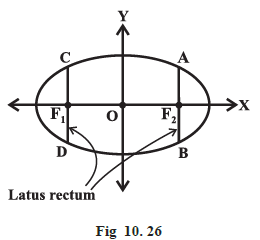
To find the length of the latus rectum of the ellipse \(\frac{x^2}{a^2}+\frac{y^2}{b^2}=1\)
Let the length of \(AF _2\) be \(l\).
Then the coordinates of \(A\) are \((c, l)\),i.e., \((a e, l)\)
Since A lies on the ellipse \(\frac{x^2}{a^2}+\frac{y^2}{b^2}=1\), we have
\(
\begin{aligned}
& \frac{(a e)^2}{a^2}+\frac{l^2}{b^2}=1 \\
& \Rightarrow l^2=b^2\left(1-e^2\right)
\end{aligned}
\)
\(
\text { But } \quad e^2=\frac{c^2}{a^2}=\frac{a^2-b^2}{a^2}=1-\frac{b^2}{a^2}
\)
\(
\text { Therefore } l^2=\frac{b^4}{a^2} \text {, i.e., } l=\frac{b^2}{a}
\)
Since the ellipse is symmetric with respect to \(y\)-axis (of course, it is symmetric w.r.t. both the coordinate axes), \(AF _2= F _2 B\) and so length of the latus rectum is \(\frac{2 b^2}{a}\).
Generally,
The equation to the ellipse, whose focus is the point \((h, k)\) and directrix is \(l x+m y+n=0\) and whose eccentricity is \(e\), is
\(
(x-h)^2+(y-k)^2=e^2 \cdot \frac{(l x+m y+n)^2}{\left(l^2+m^2\right)}
\)
Example 1: Find the coordinates of the foci, the vertices, the length of major axis, the minor axis, the eccentricity and the latus rectum of the ellipse
\(
\frac{x^2}{25}+\frac{y^2}{9}=1
\)
Answer: Since denominator of \(\frac{x^2}{25}\) is larger than the denominator of \(\frac{y^2}{9}\), the major axis is along the \(x\)-axis. Comparing the given equation with \(\frac{x^2}{a^2}+\frac{y^2}{b^2}=1\), we get
\(
\begin{aligned}
& a=5 \text { and } b=3 . \text { Also } \\
& c=\sqrt{a^2-b^2}=\sqrt{25-9}=4
\end{aligned}
\)
Therefore, the coordinates of the foci are \((-4,0)\) and \((4,0)\), vertices are \((-5,0)\) and \((5,0)\). Length of the major axis is 10 units length of the minor axis \(2 b\) is 6 units and the eccentricity is \(\frac{4}{5}\) and latus rectum is \(\frac{2 b^2}{a}=\frac{18}{5}\).
Example 2: Find the coordinates of the foci, the vertices, the lengths of major and minor axes and the eccentricity of the ellipse \(9 x^2+4 y^2=36\).
Answer: The given equation of the ellipse can be written in standard form as
\(
\frac{x^2}{4}+\frac{y^2}{9}=1
\)
Since the denominator of \(\frac{y^2}{9}\) is larger than the denominator of \(\frac{x^2}{4}\), the major axis is along the \(y\)-axis. Comparing the given equation with the standard equation \(\frac{x^2}{b^2}+\frac{y^2}{a^2}=1\), we have \(b=2\) and \(a=3\).
Also \(c=\sqrt{a^2-b^2}=\sqrt{9-4}=\sqrt{5}\)
and \(e=\frac{c}{a}=\frac{\sqrt{5}}{3}\)
Hence the foci are \((0, \sqrt{5})\) and \((0,-\sqrt{5})\), vertices are \((0,3)\) and \((0,-3)\), length of the major axis is 6 units, the length of the minor axis is 4 units and the eccentricity of the ellipse is \(\frac{\sqrt{5}}{3}\).
Example 3: Find the equation of the ellipse whose vertices are \(( \pm 13,0)\) and foci are \(( \pm 5,0)\).
Answer: Since the vertices are on \(x\)-axis, the equation will be of the form \(\frac{x^2}{a^2}+\frac{y^2}{b^2}=1\), where \(a\) is the semi-major axis.
Given that \(a=13, c= \pm 5\).
Therefore, from the relation \(c^2=a^2-b^2\), we get
\(
25=169-b^2 \text {, i.e., } b=12
\)
Hence the equation of the ellipse is \(\frac{x^2}{169}+\frac{y^2}{144}=1\).
Example 4: Find the equation of the ellipse, whose length of the major axis is 20 and foci are \((0, \pm 5)\).
Answer: Since the foci are on \(y\)-axis, the major axis is along the \(y\)-axis. So, equation of the ellipse is of the form \(\frac{x^2}{b^2}+\frac{y^2}{a^2}=1\).
Given that
\(
a=\text { semi-major axis }=\frac{20}{2}=10
\)
\(
\begin{aligned}
\text { and the relation } & c^2=a^2-b^2 \text { gives } \\
& 5^2=10^2-b^2 \text { i.e., } b^2=75
\end{aligned}
\)
Therefore, the equation of the ellipse is
\(
\frac{x^2}{75}+\frac{y^2}{100}=1
\)
Example 5: Find the equation of the ellipse, with major axis along the \(x\)-axis and passing through the points \((4,3)\) and \((-1,4)\).
Answer: The standard form of the ellipse is \(\frac{x^2}{a^2}+\frac{y^2}{b^2}=1\). Since the points \((4,3)\) and \((-1,4)\) lie on the ellipse, we have
\(
\begin{aligned}
& \frac{16}{a^2}+\frac{9}{b^2}=1 \\
\text { and } & \frac{1}{a^2}+\frac{16}{b^2}=1
\end{aligned}
\)
Solving equations (1) and (2), we find that \(a^2=\frac{247}{7}\) and \(b^2=\frac{247}{15}\).
Hence the required equation is
\(
\frac{x^2}{\left(\frac{247}{7}\right)}+\frac{y^2}{\frac{247}{15}}=1 \text {, i.e., } 7 x^2+15 y^2=247 \text {. }
\)
The Foci and Two Directrices of an Ellipse
Let \(S\) be the focus and \(Z M\) the directrix of the ellipse. Drow \(S Z \perp Z M\). Divide \(S Z\) internally and externally in the ratio \(e: 1(0<e<1)\) and let \(A\) and \(A^{\prime}\) be these internal and external point of division

On the negative side of origin take a point \(S^{\prime}\) which is such that
\(
C S=C S^{\prime}=a e
\)
and another point \(Z^{\prime}\), then
\(
C Z=C Z^{\prime}=\frac{a}{e}
\)
\(\therefore\) Coordinates of \(S^{\prime}\) are \((-a e, 0)\) and equation of second directrix (i.e., \(Z^{\prime} M^{\prime}\) ) is \(x=-\frac{a}{e}\)
Let \(P(x, y)\) be any point on the ellipse, then
\(
S^{\prime} P=e P M^{\prime}
\)
or \(\left(S^{\prime} P\right)^2=e^2\left(P M^{\prime}\right)^2\)
or \(\quad(x+a e)^2+(y-0)^2=e^2\left(x+\frac{a}{e}\right)^2\)
or \(\quad(x+a e)^2+y^2=(e x+a)^2\)
or \(\quad x^2\left(1-e^2\right)+y^2=a^2\left(1-e^2\right)\)
or \(\quad \frac{x^2}{a^2}+\frac{y^2}{a^2\left(1-e^2\right)}=1\)
or \(\quad \frac{x^2}{a^2}+\frac{y^2}{b^2}=1\),
where, \(b^2=a^2\left(1-e^2\right)\)
The equation being the same as that of the ellipse when \(S(a e, 0)\) is focus and \(M Z\) i.e. \(x=a / e\) is directrix. Hence, coordinates of foci are \(( \pm a e, 0)\) and equations of directrices are \(x= \pm a / e\).
Remarks
- Distance between foci \(S S^{\prime}=2 a e\) and distance between directrices \(Z ^{\prime}=2 a / e\)
- If \(e=0\)
then \(b^2=a^2(1-0)\)
\(\therefore \quad b^2=a^2\)
then equation of ellipse \(\frac{x^2}{a^2}+\frac{y^2}{b^2}=1\) changes in circle i.e.
\(
x^2+y^2=a^2
\) - Since, \(\frac{x^2}{a^2}+\frac{y^2}{b^2}=1\)
\(
\begin{aligned}
\Rightarrow \quad \frac{y^2}{b^2} & =1-\frac{x^2}{a^2}=\frac{a^2-x^2}{a^2} \\
\frac{y^2}{b^2} & =\frac{(a+x)(a-x)}{a^2}
\end{aligned}
\)
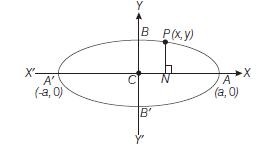
or \(\quad \frac{(P N)^2}{b^2}=\frac{A^{\prime} N \cdot A N}{a^2}\)
or \(\quad \frac{(P N)^2}{A N \cdot A^{\prime} N}=\frac{b^2}{a^2}=\frac{(B C)^2}{(A C)^2}\)
i.e. \((P N)^2: A N \cdot A^{\prime} N::(B C)^2:(A C)^2\)
- The distance of every focus from the extremity of minor axis is equal to a.
i.e. \(\sqrt{\left(a^2 e^2+b^2\right)}=\sqrt{\left(a^2-b^2+b^2\right)}=a\) - Area of the ellipse \(\frac{x^2}{a^2}+\frac{y^2}{b^2}=1\) is \(\pi a b\).
Some Terms Related to an Ellipse
Let the equation of the ellipse \(\frac{x^2}{a^2}+\frac{y^2}{b^2}=1\) \((a>b)\)
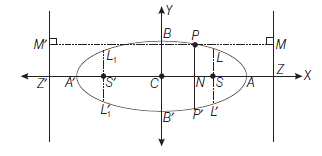
- Centre : All chords passing through \(C\) is bisected at \(C\) Here \(C \equiv(0,0)\)
- Foci : \(S\) and \(S^{\prime}\) are two foci of the ellipse and their coordinates are \((a e, 0)\) and \((-a e, 0)\) respectively.
- Directrices: \(Z M\) and \(Z^{\prime} M^{\prime}\) are two directrices of the ellipse and their equation are \(x=\frac{a}{e}\) and \(x=-\frac{a}{e}\) respectively.
- Axes: The lines \(A A^{\prime}\) and \(B B^{\prime}\) are called the major and minor axes of the ellipse
\(
\because \quad 0<e<1
\)
\(
\begin{array}{llr}
\text { or } & 0<e^2<1 & \left(\therefore 0>-e^2>-1\right) \\
\text { or } & 0<1-e^2<1 & \left(\text { or } 1>1-e^2>1-1\right) \\
\text { or } & a^2\left(1-e^2\right)<a^2 & \left(\text { or } 0<1-e^2<1\right)
\end{array}
\)
or \(b^2<a^2\)
i.e. \(b<a\)
The major and minor axis together are called principal axes of the ellipse. - Double ordinates : If \(P\) be a point on the ellipse draw \(P N\) perpendicular to the axis of the ellipse and produced to meet the curve again at \(P^{\prime}\). Then \(P P^{\prime}\) is called a double ordinate.
If abscissa of \(P\) is \(h\), then ordinate of \(P\),
\(
\frac{y^2}{b^2}=1-\frac{h^2}{a^2}
\)
\(
y=\frac{b}{a} \sqrt{\left(a^2-h^2\right)} \text { (for first quadrant) }
\)
and ordinate of \(P^{\prime}\) is
\(
y=-\frac{b}{a} \sqrt{\left(a^2-h^2\right)} \text { (for fourth quadrant) }
\)
Hence, coordinates of \(P\) and \(P^{\prime}\) are
\(
\left(h, \frac{b}{a} \sqrt{\left(a^2-h^2\right)}\right) \text { and }\left(h,-\frac{b}{a} \sqrt{\left(a^2-h^2\right)}\right)
\)
respectively. - Latusrectum The double ordinates \(L L^{\prime}\) and \(L_1 L_1{ }^{\prime}\) are latusrectums of the ellipse. These line are perpendicular to major axis \(A^{\prime} A\) and through the foci \(S\) and \(S^{\prime}\), respectively.
Length of the latusrectum
Now let
\(
L L^{\prime}=2 k
\)
then
\(
L S=L^{\prime} S=k
\)
Coordinates of \(L\) and \(L^{\prime}\) are \((a e, k)\) and \((a e,-k)\) lies on the ellipse
\(
\begin{gathered}
\frac{x^2}{a^2}+\frac{y^2}{b^2}=1 \\
\therefore \quad \frac{a^2 e^2}{a^2}+\frac{k^2}{b^2}=1 \text { or } k^2=b^2\left(1-e^2\right) \\
=b^2\left(\frac{b^2}{a^2}\right) \quad\left[\because b^2=a^2\left(1-e^2\right)\right]
\end{gathered}
\)
\(
\therefore \quad k=\frac{b^2}{a} \quad(\because k>0)
\)
\(
\therefore \quad 2 k=\frac{2 b^2}{a}=L L^{\prime}
\)
\(\therefore\) Length of latusrectum \(L L^{\prime}=L_1 L_1{ }^{\prime}=\frac{2 b^2}{a}\) and end of points of latusrectum are
\(
\begin{aligned}
L & \equiv\left(a e, \frac{b^2}{a}\right) ; L^{\prime} \equiv\left(a e,-\frac{b^2}{a}\right) \\
L_1 & \equiv\left(-a e, \frac{b^2}{a}\right) ; L_1{ }^{\prime} \equiv\left(-a e,-\frac{b^2}{a}\right)
\end{aligned}
\)
respectively.
Remark
- Latusrectum
\(
\begin{aligned}
& =L L^{\prime}=\frac{2 b^2}{a}=\frac{(2 b)^2}{(2 a)}=\frac{(\text { Minor axis })^2}{(\text { Major axis })} \\
& =2 a\left(1-e^2\right)=2 e\left(\frac{a}{e}-a e\right)
\end{aligned}
\)
\(=2 e(\) distance from focus to the corresponding directrix \()\) - Focal chord : A chord of the ellipse passing through its focus is called a focal chord.
- Semi latusrectum is the harmonic mean of the segments of focal chord or \(\frac{1}{S P}+\frac{1}{S Q}=\frac{2 a}{b^2}(a>b)\), where \(P Q\) is the focal chord and \(S\) is the focus.
- Vertices: The vertices of the ellipse are the points where the ellipse meets its major axis. Hence, \(A\) and \(A^{\prime}\) are the vertices
\(\therefore \quad A \equiv(a, 0)\) and \(A^{\prime} \equiv(-a, 0)\)
Example 6: If \(P S Q\) is a focal chord of the ellipse \(16 x^2+25 y^2=400\), such that \(S P=8\), then find the length of \(S Q\).
Answer: The given ellipse is \(16 x^2+25 y^2=400\) or \(\frac{x^2}{25}+\frac{y^2}{16}=1\)
\(
\begin{aligned}
& \frac{1}{S P}+\frac{1}{S Q}=\frac{2 a}{b^2} \\
& \Rightarrow \quad \frac{1}{8}+\frac{1}{S Q}=\frac{2(5)}{16}=\frac{5}{8} \text { or } \frac{1}{S Q}=\frac{1}{2} \\
& \therefore \quad S Q=2 \\
&
\end{aligned}
\)
Example 7: If the latusrectum of an ellipse is equal to half of its minor-axis, then find its eccentricity.
Answer: \(\because\) Latusrectum \(=\frac{1}{2}(\) minor axis \()\)
\(
\begin{aligned}
& \Rightarrow \quad \frac{2 b^2}{a}=\frac{1}{2}(2 b) \\
& \text { or } \quad 2 b=a \\
& \text { or } \quad 4 b^2=a^2 \\
& \Rightarrow \quad 4 a^2\left(1-e^2\right)=a^2 \\
& \text { or } 4 e^2=3 \\
& \therefore \quad e=\frac{\sqrt{3}}{2} \\
&
\end{aligned}
\)
Example 8: If the distance between the directrices is thrice the distance between the foci, then find eccentricity of the ellipse.
Answer: Given, \(\frac{2 a}{e}=3(2 a e) \Rightarrow e^2=\frac{1}{3}\)
\(
\therefore \quad e=\frac{1}{\sqrt{3}}
\)
Example 9: If \(P(x, y)\) be any point on the ellipse \(16 x^2+25 y^2=400\) and \(F_1 \equiv(3,0), F_2 \equiv(-3,0)\), then find the value of \(P F_1+P F_2\).
Answer: We have, \(16 x^2+25 y^2=400\)
\(\Rightarrow \quad \frac{x^2}{5^2}+\frac{y^2}{4^2}=1\)
\(\because\) Coordinates of foci an \(( \pm a e, 0)\)
or \(\quad\left( \pm \sqrt{\left(a^2-b^2\right)}, 0\right)\)
i.e. \(\quad( \pm \sqrt{(25-16)}, 0)\) or \(( \pm 3,0)\)
Thus, \(F_1\) and \(F_2\) are foci of the ellipse.
\(
\begin{aligned}
\therefore \quad P F_1+P F_2 & =\text { Length of major axis } \\
& =2 a=2 \times 5=10
\end{aligned}
\)
Parametric equation of the ellipse:
The circle described on the major-axis of an ellipse as diameter is called the auxiliary circle of the ellipse.
Let the equation of ellipse be
\(
\frac{x^2}{a^2}+\frac{y^2}{b^2}=1
\)
\(\therefore\) Equation of its auxiliary circle is \(x^2+y^2=a^2\left(\because A A^{\prime}\right.\) is diameter of the circle \()\)

Let \(Q\) be a point on the auxiliary circle \(x^2+y^2=a^2\) such that \(Q P\) produced is perpendicular to the \(X\)-axis. Then \(P\) and \(Q\) are the corresponding points on the ellipse and the auxiliary circle respectively.
Let \(\angle Q C A=\phi\)
\((0 \leq \phi<2 \pi)\)
i.e. the eccentric angle of \(P\) on an ellipse is the angle which the radius (or radius vector) through the corresponding point on the auxiliary circle makes with the major axis.
\(\therefore \quad Q \equiv(a \cos \phi, a \sin \phi)\)
\(\therefore\) Now \(x\)-coordinate of \(P\) is \(a \cos \phi\)
Let \(y\)-coordinate of \(P\) is \(y\), then \((a \cos \phi, y)\) lies on the ellipse
\(
\begin{aligned}
\frac{x^2}{a^2}+\frac{y^2}{b^2} & =1 \\
\frac{a^2 \cos ^2 \phi}{a^2}+\frac{y^2}{b^2} & =1
\end{aligned}
\)
\(
\begin{aligned}
& \Rightarrow \quad y^2=b^2 \sin ^2 \phi \\
& \therefore \quad y= \pm b \sin \phi \\
&
\end{aligned}
\)
\(\because P\) is in \(I\) quadrant
\(
\therefore \quad y=b \sin \phi
\)
Coordinates of \(P\) are \((a \cos \phi, b \sin \phi)\). We have \(x=a \cos \phi, y=b \sin \phi\) are called parametric equations of the ellipse.
This point \((a \cos \phi, b \sin \phi)\) is also called the point ‘ \(\phi\) ‘.
Remark
- The equation of the chord joining the points
\(
\text { and } \begin{aligned}
& P \equiv\left(a \cos \phi_1, b \sin \phi_1\right) \\
\text { and } & Q \equiv\left(a \cos \phi_2, b \sin \phi_2\right) \text { is } \\
& \frac{x}{a} \cos \left(\frac{\phi_1+\phi_2}{2}\right)+\frac{y}{b} \sin \left(\frac{\phi_1+\phi_2}{2}\right)=\cos \left(\frac{\phi_1-\phi_2}{2}\right)
\end{aligned}
\)
If its focal chord, then it pass through \((a e, 0)\) or \((-a e, 0)\), then
\(
\begin{aligned}
& \pm \cos \left(\frac{\phi_1+\phi_2}{2}\right)+0=\cos \left(\frac{\phi_1-\phi_2}{2}\right) \\
\Rightarrow \quad & \frac{\cos \left(\frac{\phi_1-\phi_2}{2}\right)}{\cos \left(\frac{\phi_1+\phi_2}{2}\right)}= \pm \frac{e}{1} \\
\Rightarrow \quad & \frac{\cos \left(\frac{\phi_1-\phi_2}{2}\right)-\cos \left(\frac{\phi_1+\phi_2}{2}\right)}{\cos \left(\frac{\phi_1-\phi_2}{2}\right)+\cos \left(\frac{\phi_1+\phi_2}{2}\right)}=\left(\frac{ \pm e-1}{ \pm e+1}\right) \\
\Rightarrow \quad & \tan \left(\frac{\phi_1}{2}\right) \tan \left(\frac{\phi_2}{2}\right)=\left(\frac{ \pm e-1}{ \pm e+1}\right)
\end{aligned}
\)
if focal chord pass through \((a e, 0)\), then
\(
\tan \left(\frac{\phi_1}{2}\right) \tan \left(\frac{\phi_2}{2}\right)=\left(\frac{e-1}{e+1}\right)
\)
and if focal chord pass through ( \(-a e, 0\) ), then
\(
\tan \left(\frac{\phi_1}{2}\right) \tan \left(\frac{\phi_2}{2}\right)=\left(\frac{e+1}{e-1}\right)
\)
or \(\cot \left(\frac{\phi_1}{2}\right) \cot \left(\frac{\phi_2}{2}\right)=\left(\frac{e-1}{e+1}\right)\)
Example 10: Prove that Circle described on focal length as diameter always touches the auxiliary circle.
Answer: Consider ellipse \(\frac{x^2}{a^2}+\frac{y^2}{b^2}=1\)
Let \(P\) be \((a \cos \theta, b \sin \theta)\)
and \(S\) be \((a e, 0)\)
\(
\begin{aligned}
\therefore \quad S P=e P M & =e\left(\frac{a}{e}-a \cos \theta\right) \\
& =(a-a e \cos \theta)
\end{aligned}
\)
The auxiliary circle \(x^2+y^2=a^2\) having center \(C(0,0)\) and radius \(r_1=a\)
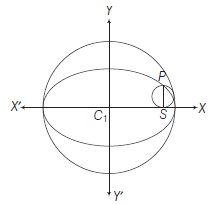
The circle having \(S P\) as the diameter has center
\(
c_2\left(\frac{a e+a \cos \theta}{2}, \frac{b \sin \theta}{2}\right)
\)
and radius \(r_2=\frac{S P}{2}=\frac{a(1-e \cos \theta)}{2}\)
Now, \(C_1 C_2=\sqrt{\left(\frac{a e+a \cos \theta}{2}\right)^2+\left(\frac{b \sin \theta}{2}\right)^2}\)
\(
\begin{aligned}
& =\frac{1}{2} \sqrt{a^2(e+\cos \theta)^2+a^p\left(1-e^2\right) \sin ^2 \theta} \\
& =\frac{a}{2} \sqrt{\left(e^2+\cos ^2 \theta+2 e \cos \theta+\sin ^2 \theta-e^2 \sin ^2 \theta\right)} \\
& =\frac{a}{2} \sqrt{\left(e^2 \cos ^2 \theta+2 e \cos \theta+1\right)} \\
& =\frac{a}{2}(1+e \cos \theta) \\
& =r_1-r_2
\end{aligned}
\)
Hence, the circle on \(S P\) as diameter touches the auxiliary circle internally.
Example 11: Find the eccentric angle of a point on the ellipse \(\frac{x^2}{6}+\frac{y^2}{2}=1\). Whose distance from the center of the ellipse is \(\sqrt{5}\).
Answer: Any point on the ellipse is \(P(\sqrt{6} \cos \theta, \sqrt{2} \sin \theta)\)
Where, \(0 \leq \theta<2 \pi\) and \(C(0,0)\) is center, given \(C P=\sqrt{5}\)
\(
\begin{array}{lr}
\Rightarrow & (C P)^2=5 \\
\Rightarrow & 6 \cos ^2 \theta+2 \sin ^2 \theta=5 \\
\Rightarrow & 6\left(1-\sin ^2 \theta\right)+2 \sin ^2 \theta=5 \\
\text { or } & \sin ^2 \theta=\frac{1}{4} \\
\text { or } & \sin \theta= \pm \frac{1}{2}= \pm \sin \frac{\pi}{6} \\
\therefore & \theta=\frac{\pi}{6}, \frac{5 \pi}{6}, \frac{7 \pi}{6}, \frac{11 \pi}{6}
\end{array}
\)
Focal Distances of a Point
The sum of focal distances of any point on the ellipse is equal to the major axis. The ellipse is
\(
\frac{x^2}{a^2}+\frac{y^2}{b^2}=1 \dots(i)
\)
The foci \(S\) and \(S^{\prime}\) are \((a e, 0)\) and \((-a e, 0)\).
The equations of its directrices \(M Z\) and \(M^{\prime} Z^{\prime}\) are \(x=a / e\) and \(x=-a / e\)
Let \(P\left(x_1, y_1\right)\) be any point on Eq. (i)
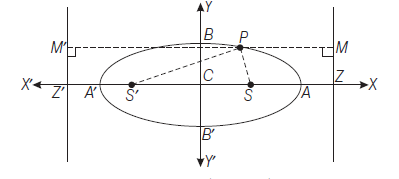
\(
\begin{aligned}
\text { Now } S P & =e P M=e\left(\frac{a}{e}-x_1\right) \\
& =a-e x_1
\end{aligned}
\)
\(
\begin{aligned}
\text { and } S^{\prime} P & =e P M^{\prime}=e\left(\frac{a}{e}+x_1\right) \\
& =a+e x_1 \\
S P+S^{\prime} P & =\left(a-e x_1\right)+\left(a+e x_1\right) \\
& =2 a=A A^{\prime}=\text { major axis }
\end{aligned}
\)
Hence, the sum of the focal distances of a point on the ellipse is constant and is equal to the length of the major axis of the ellipse.
Remark
- \(S P\) and \(S^{\prime} P\) are also called focal radii of the ellipse
\(
\therefore \quad S P=a-e x_1 \quad \text { and } \quad S^{\prime} P=a+e x_1
\)
Example 12: An ellipse having foci at \((3,3)\) and \((-4,4)\) and passing through the origin, then find eccentricity of the ellipse.
Answer: The ellipse is passing through \(O(0,0)\) and has foci \(P(3,3)\) and \(Q(-4,4)\), then
\(
O P+O Q=2 a \text { and } P Q=2 a e
\)
\(
\therefore \quad e=\frac{P Q}{O P+O Q}=\frac{\sqrt{50}}{3 \sqrt{2}+4 \sqrt{2}}=\frac{5}{7}
\)
The Shape of the Ellipse \(\frac{x^2}{a^2}+\frac{y^2}{b^2}=1\), when \(b>a\)
In this case major and minor-axis of the ellipse along \(Y\)-axis and \(X\)-axis respectively.
then \(A A^{\prime}=2 b \text { and } B B^{\prime}=2 a\)
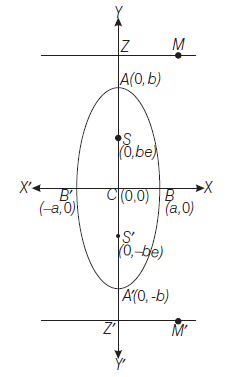
The foci \(S\) and \(S^{\prime}\) are \((0, b e)\) and \((0,-b e)\) respectively The directrices are \(M Z\) and \(M^{\prime} Z^{\prime}\) are
\(
y=\frac{b}{e} \quad \text { and } \quad y=-\frac{b}{e}
\)
are respectively,
Mechanical Construction of an Ellipse
Let \(S\) and \(S^{\prime}\) be two drawing pins and let an inextensible string whose ends at \(S\) and \(S^{\prime}\) and length is equal to sum of \(S P\) and \(S^{\prime} P\) i.e. \(2 a\), where \(P\) is point of pencil. The point of pencil move on paper and the fixed ends always tight. So as to satisfy these conditions it will trace out the curve on the paper. This curve is an ellipse. Hence the locus of the point of pencil is an ellipse.
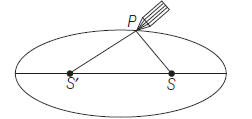
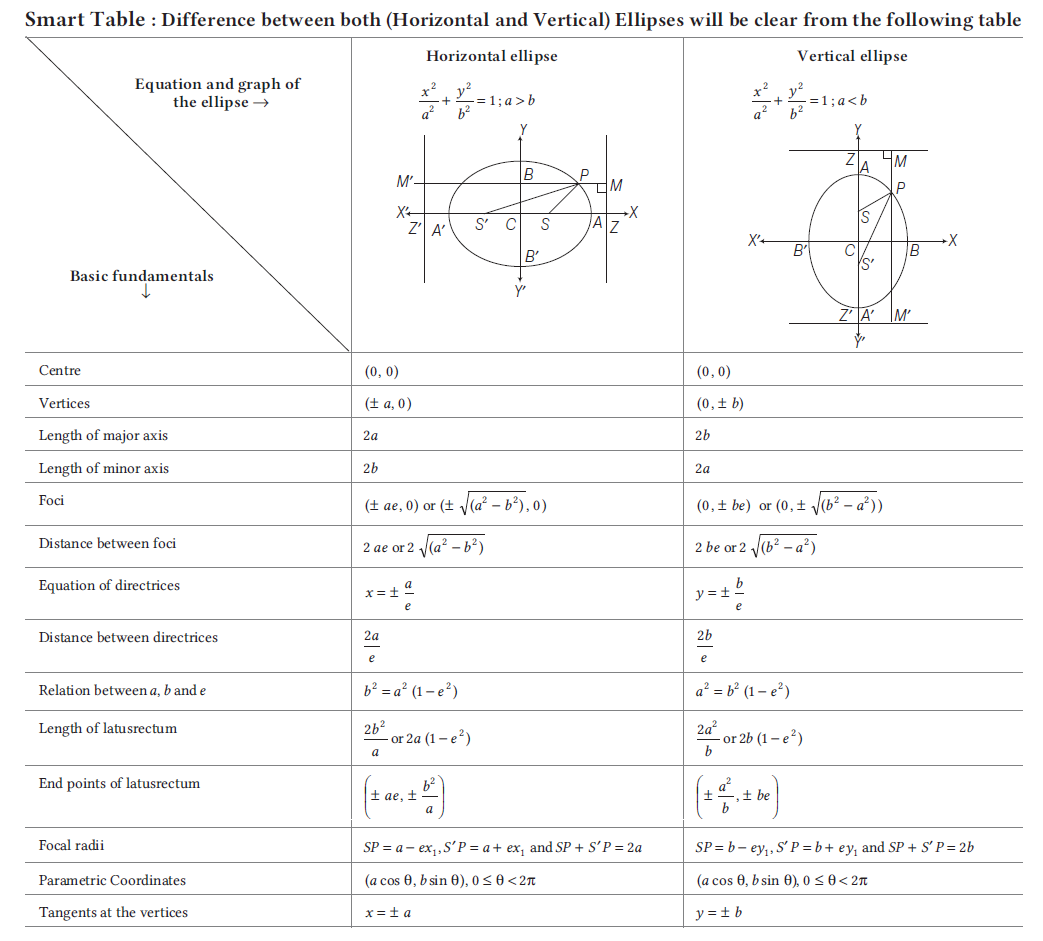
Example 13: Find the lengths of major and minor axes, the coordinates of foci, vertices and the eccentricity of the ellipse \(3 x^2+2 y^2=6\). Also, find the equation of the directrices.
Answer: The equation of ellipse is
\(
\begin{array}{rlrl}
3 x^2+2 y^2 & =6 \\
\Rightarrow & \frac{x^2}{2}+\frac{y^2}{3} & =1 \\
\Rightarrow & \frac{x^2}{(\sqrt{2})^2}+\frac{y^2}{(\sqrt{3})^2} & =1
\end{array}
\)
Comparing this equation with
\(
\begin{array}{ll}
& \frac{x^2}{a^2}+\frac{y^2}{b^2}=1 \\
\therefore & a=\sqrt{2}, b=\sqrt{3} \text { (Here } b>a \text { ) }
\end{array}
\)
\(
\begin{aligned}
& \text { Length of major axis }=2 b=2 \sqrt{3} \\
& \text { and Length of minor axis }=2 a=2 \sqrt{2} \\
& \text { If } e \text { be the eccentricity, then } a^2=b^2\left(1-e^2\right) \\
& \Rightarrow \quad 2=3\left(1-e^2\right) \Rightarrow e^2=\frac{1}{3} \\
& \therefore \quad e=\frac{1}{\sqrt{3}} \\
& \text { Vertices }=(0, \pm b)=(0, \pm \sqrt{3}) \\
& \text { and foci are }(0, \pm b e)=(0, \pm 1) \\
& \text { and equation of the directrices are } y= \pm b / e \\
& \qquad y= \pm \frac{\sqrt{3}}{(1 / \sqrt{3})} \\
& \therefore \quad y= \pm 3
\end{aligned}
\)
Example 14: Find the equation of an ellipse whose focus is \((-1,1)\), eccentricity is \(\frac{1}{2}\) and the directrix is \(x-y+3=0\).
Answer: Let \(P(x, y)\) be any point on the ellipse whose focus is \(S(-1,1)\) and the directrix is \(x-y+3=0\). Draw \(P M\) perpendicular from \(P(x, y)\) on the directrix \(x-y+3=0\). Then by definition
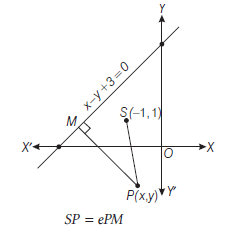
\(
\begin{array}{lc}
\Rightarrow & (S P)^2=e^2(P M)^2 \\
\Rightarrow & (x+1)^2+(y-1)^2=\frac{1}{4}\left\{\frac{x-y+3}{\sqrt{2}}\right\}^2
\end{array}
\)
\(
\begin{gathered}
\Rightarrow \quad 8\left(x^2+y^2+2 x-2 y+2\right) \\
\quad=x^2+y^2+9-2 x y+6 x-6 y \\
\Rightarrow \quad 7 x^2+7 y^2+2 x y+10 x-10 y+7=0
\end{gathered}
\)
which is the required equation of the ellipse.
Example 15: Show that the line \(l x+m y+n=0\) will cut the ellipse \(x^2 / a^2+y^2 / b^2=1\) in points whose eccentric angles differ by \((\pi / 2)\), if \(a^2 I^2+b^2 m^2=2 n^2\).
Answer: Let eccentric angles are \(\theta\) and \(\phi\), then
\(
\theta-\phi=\frac{\pi}{2} \text { (given) }
\)
\(
\therefore \quad \theta=\frac{\pi}{2}+\phi
\)
The line joining the point ‘ \(\theta\) ‘ and ‘ \(\phi\) ‘ is
\(
\begin{aligned}
\frac{x}{a} \cos \left(\frac{\theta+\phi}{2}\right)+\frac{y}{b} \sin \left(\frac{\theta+\phi}{2}\right) & =\cos \left(\frac{\theta-\phi}{2}\right) \\
\text { or } \frac{x}{a} \cos \left(\frac{\pi}{4}+\phi\right)+\frac{y}{b} \sin \left(\frac{\pi}{4}+\phi\right) & =\cos \frac{\pi}{4}\left(\because \theta=\frac{\pi}{2}+\phi\right)
\end{aligned}
\)
\(
\text { or } \frac{x}{a} \cos \left(\frac{\pi}{4}+\phi\right)+\frac{y}{b} \sin \left(\frac{\pi}{4}+\phi\right)=\frac{1}{\sqrt{2}} \dots(i)
\)
and the given line is \(l x+m y+n=0\)
or \(l x+m y=-n \dots(ii)\)
Now, Eqs. (i) and (ii) represent the same line, so comparing them, we get
\(
\begin{aligned}
& \frac{\cos \left(\frac{\pi}{4}+\phi\right)}{l a}=\frac{\sin \left(\frac{\pi}{4}+\phi\right)}{m b}=-\frac{1}{n \sqrt{2}} \\
& \therefore \quad \cos \left(\frac{\pi}{4}+\phi\right)=-\frac{l a}{n \sqrt{2}} \dots(iii)
\end{aligned}
\)
\(
\text { and } \quad \sin \left(\frac{\pi}{4}+\phi\right)=-\frac{m b}{n \sqrt{2}} \dots(iv)
\)
Squaring and adding Eqs. (iii) and (iv), then
\(
\begin{aligned}
\frac{l^2 a^2}{2 n^2}+\frac{m^2 b^2}{2 n^2} & =1 \\
l^2 a^2+m^2 b^2 & =2 n^2
\end{aligned}
\)
Example 16: If a chord joining two points whose eccentric angles are \(\alpha, \beta\) cut the major axis of an ellipse at a distance \(d\) from the centre. Show that \(\tan (\alpha / 2) \tan (\beta / 2)=(d-a) /(d+a)\), where \(2 a\) is the length of major axis.
Answer: Let the equation of the ellipse be
\(
\frac{x^2}{a^2}+\frac{y^2}{b^2}=1 \dots(i)
\)
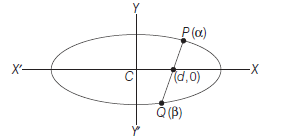
The equation of the line joining ‘ \(\alpha\) ‘ and ‘ \(\beta\) ‘ on the ellipse Eq. (i) is
\(
\frac{x}{a} \cos \left(\frac{\alpha+\beta}{2}\right)+\frac{y}{b} \sin \left(\frac{\alpha+\beta}{2}\right)=\cos \left(\frac{\alpha-\beta}{2}\right) \dots(ii)
\)
Since, it cuts the major axis of the ellipse at a distance \(d\) from the centre i.e. passes through the point \((d, 0)\), then \(\frac{d}{a} \cos \left(\frac{\alpha+\beta}{2}\right)+0=\cos \left(\frac{\alpha-\beta}{2}\right)\)
\(
\text { or } \quad \frac{d}{a}=\frac{\cos \left(\frac{\alpha-\beta}{2}\right)}{\cos \left(\frac{\alpha+\beta}{2}\right)}
\)
\(
\text { or } \quad \frac{d-a}{d+a}=\frac{\cos \left(\frac{\alpha-\beta}{2}\right)-\cos \left(\frac{\alpha+\beta}{2}\right)}{\cos \left(\frac{\alpha-\beta}{2}\right)+\cos \left(\frac{\alpha+\beta}{2}\right)} \text { (By componendo and dividendo) }
\)
\(
\begin{aligned}
&=\frac{2 \sin (\alpha / 2) \sin (\beta / 2)}{2 \cos (\alpha / 2) \cos (\beta / 2)} \\
&=\tan (\alpha / 2) \tan (\beta / 2) \\
& \therefore \quad \tan (\alpha / 2) \tan (\beta / 2)=\frac{d-a}{d+a}
\end{aligned}
\)
Example 17: If the angle between the straight lines joining foci and the ends of the minor axis of the ellipse \(\frac{x^2}{a^2}+\frac{y^2}{b^2}=1\), is \(90^{\circ}\). Find its eccentricity.
Answer: The equation of the ellipse is \(\frac{x^2}{a^2}+\frac{y^2}{b^2}=1\)
Let \(a>b\)
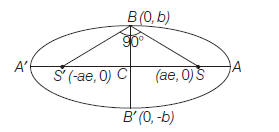
\(\therefore\) The ends of minor axis are \(B(0, b)\) and \(B^{\prime}(0,-b)\). If the eccentricity of the ellipse is \(e\), then the foci are \(S(a e, 0)\) and \(S^{\prime}(-a e, 0)\)
\(
\begin{aligned}
& \therefore \quad \text { Slope of } B S \text { is } m_1=\frac{b-0}{0-a e}=-\frac{b}{a e} \\
& \text { and slope of } B S^{\prime} \text { is } m_2=\frac{b-0}{0+a e}=\frac{b}{a e}
\end{aligned}
\)
\(\because\) The angle between \(B S\) and \(B S^{\prime}\) is \(90^{\circ}\),
\(
\begin{array}{llrl}
\therefore & m_1 m_2 & =-1 \\
\Rightarrow & -\frac{b}{a e} \times \frac{b}{a e} & =-1
\end{array}
\)
\(
\begin{aligned}
\Rightarrow b^2 & =a^2 e^2 \\
a^2\left(1-e^2\right) & =a^2 e^2
\end{aligned}
\)
\(
\begin{array}{rlrl}
\Rightarrow & 1-e^2 & =e^2 \\
\Rightarrow & 2 e^2 & =1 \\
& \therefore & e & =\frac{1}{\sqrt{2}}
\end{array}
\)
Example 18: Find the equation of the ellipse referred to its centre whose minor axis is equal to the distance between the foci and whose latusrectum is 10.
Answer: Let the equation of the ellipse is
\(
\frac{x^2}{a^2}+\frac{y^2}{b^2}=1 \text { (let } a>b \text { ) }
\)
Then, the foci are \(S(a e, 0)\) and \(S^{\prime}(-a e, 0)\), length of minor axis \(B B^{\prime}=2 b\) and length of latusrectum \(=\frac{2 b^2}{a}\)
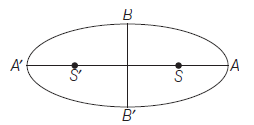
\(\therefore\) According to the question
\(
\begin{aligned}
& B B^{\prime}=S S^{\prime} \Rightarrow 2 b=2 a e \\
& \Rightarrow \quad b=a e \dots(i) \\
& \text { and } \quad \frac{2 b^2}{a}=10 \\
& \Rightarrow \quad b^2=5 a \dots(ii)\\
&
\end{aligned}
\)
also we have \(b^2=a^2\left(1-e^2\right) \dots(iii)\)
Putting the value of \(b\) from Eq. (i) in Eq. (iii), we have
\(
\begin{aligned}
& & a^2 e^2 & =a^2\left(1-e^2\right) \\
\Rightarrow & & e^2 & =1-e^2 \\
\Rightarrow & & 2 e^2 & =1 \\
& \therefore & e & =\frac{1}{\sqrt{2}}
\end{aligned}
\)
From Eq. (i), we have
\(
\begin{aligned}
b & =\frac{a}{\sqrt{2}} \\
\therefore \quad b^2 & =\frac{a^2}{2}
\end{aligned}
\)
\(
\begin{array}{lll}
\Rightarrow & 5 a=\frac{a^2}{2} & \text { [from Eq. (ii)] }
\end{array}
\)
\(\Rightarrow \quad a=10\)
From Eq. (ii)
\(
b^2=5 \times 10=50
\)
Putting the values of \(a\) and \(b\) in \(\frac{x^2}{a^2}+\frac{y^2}{b^2}=1\), the equation of required ellipse is
\(
\begin{aligned}
& \frac{x^2}{100}+\frac{y^2}{50}=1 \\
& x^2+2 y^2=100
\end{aligned}
\)
Example 19: Prove that the ratio of area of any triangle \(P Q R\) inscribed in the ellipse \(\frac{x^2}{a^2}+\frac{y^2}{b^2}=1\) and that of triangle formed by the corresponding points on the auxiliary circle is \(\frac{b}{a}\).
Answer: Let the three points on the ellipse be \(P(a \cos \alpha, b \sin \alpha)\), \(Q(a \cos \beta, b \sin \beta)\) and \(R(a \cos \gamma, b \sin \gamma)\).
Then, the corresponding points on the auxiliary circle are \(A(a \cos \alpha, a \sin \alpha), B(a \cos \beta, a \sin \beta)\) and \(C(a \cos \gamma, a \sin \gamma)\), then
\(
\begin{aligned}
& \frac{\text { Area of } \triangle P Q R}{\text { Area of } \triangle A B C}=\frac{\frac{1}{2}\left|\begin{array}{lll}
a \cos \alpha & b \sin \alpha & 1 \\
a \cos \beta & b \sin \beta & 1 \\
a \cos \gamma & b \sin \gamma & 1
\end{array}\right|}{\frac{1}{2}\left|\begin{array}{lll}
a \cos \alpha & a \sin \alpha & 1 \\
a \cos \beta & a \sin \beta & 1 \\
a \cos \gamma & a \sin \gamma & 1
\end{array}\right|} \\
& =\frac{a b\left|\begin{array}{ccc}
\cos \alpha & \sin \alpha & 1 \\
\cos \beta & \sin \beta & 1 \\
\cos \gamma & \sin \gamma & 1
\end{array}\right|}{a^2\left|\begin{array}{ccc}
\cos \alpha & \sin \alpha & 1 \\
\cos \beta & \sin \beta & 1 \\
\cos \gamma & \sin \gamma & 1
\end{array}\right|} \\
& =\frac{b}{a} \\
&
\end{aligned}
\)
Example 20: The extremities of a line segment of length \(l\) move in two fixed perpendicular straight lines. Find the locus of that point which divides this line segment in ratio \(1: 2\).
Answer:
\(\begin{aligned}
& \text { Let } P A: P B=1: 2 \\
& \qquad \begin{aligned}
P A & =\frac{l}{3} \quad \text { and } P B=\frac{2 l}{3} \\
k & =\frac{l}{3} \sin \theta \\
\text { or } \quad 3 k & =l \sin \theta \\
\text { and } \quad h & =\frac{2 l}{3} \cos \theta \dots(i)
\end{aligned}
\end{aligned}
\)
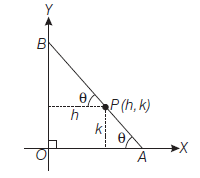
\(
\text { or } \quad \frac{3 h}{2}=l \cos \theta \dots(ii)
\)
Squaring and adding Eqs. (i) and (ii), then
\(
\begin{aligned}
9 k^2+\frac{9 h^2}{4} & =l^2 \\
\text { or } \quad 9 h^2+36 k^2 & =4 l^2
\end{aligned}
\)
\(\therefore\) Locus of \(P(h, k)\) is
\(
9 x^2+36 y^2=4 l^2
\)
Example 21: Find the lengths and equations of the focal radii drawn from the point \((4 \sqrt{3}, 5)\) on the ellipse \(25 x^2+16 y^2=1600\).
Answer: The equation of the ellipse is
\(
\begin{aligned}
25 x^2+16 y^2 & =1600 \\
\frac{x^2}{64}+\frac{y^2}{100} & =1
\end{aligned}
\)
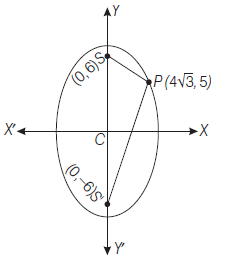
Here, \(b>a\)
\(
\begin{array}{rlrl}
& a^2 & =64, b^2=100 \\
& a^2 & =b^2\left(1-e^2\right) \\
\therefore & 64 & =100\left(1-e^2\right) \\
\Rightarrow & e =3 / 5
\end{array}
\)
Let \(\quad P\left(x_1, y_1\right) \equiv(4 \sqrt{3}, 5)\)
be a point on the ellipse, then \(S P\) and \(S^{\prime} P\) are the focal radii
\(
\begin{array}{ll}
\therefore & S P=b-e y_1 \text { and } S^{\prime} P=b+e y_1 \\
\therefore & S P=10-\frac{3}{5} \times 5 \text { and } S^{\prime} P=10+\frac{3}{5} \times 5 \\
\Rightarrow & S P=7 \text { and } S^{\prime} P=13
\end{array}
\)
Also, \(S\) is \((0, b e)\)
i.e. \(\quad\left(0,10 \times \frac{3}{5}\right)\) i.e. \((0,6)\)
and \(S^{\prime}\) is \((0,-b e)\)
i.e. \(\left(0,-10 \times \frac{3}{5}\right)\)
i.e. \((0,-6)\)
\(\therefore\) Equation of \(S P\) is
\(
y-5=\frac{6-5}{0-4 \sqrt{3}}(x-4 \sqrt{3})
\)
\(
\begin{aligned}
-4 \sqrt{3 y}+20 \sqrt{3} & =x-4 \sqrt{3} \\
x+4 \sqrt{3} y-24 \sqrt{3} & =0
\end{aligned}
\)
and equation of \(S^{\prime} P\) is
\(
\therefore \quad y-5=\frac{-6-5}{0-4 \sqrt{3}}(x-4 \sqrt{3})
\)
\(
\begin{array}{ll}
\Rightarrow & -4 \sqrt{3} y+20 \sqrt{3}=-11 x+44 \sqrt{3} \\
\text { or } & 11 x-4 \sqrt{3} y-24 \sqrt{3}=0
\end{array}
\)
Position of a Point with Respect to an Ellipse
Theorem : Prove that the point \(P\left(x_1, y_1\right)\) lies outside, on, or inside the ellipse \(\frac{x^2}{a^2}+\frac{y^2}{b^2}=1\) according as
\(
\frac{x_1^2}{a^2}+\frac{y_1^2}{b^2}-1>,=\text { or },<0
\)
Proof : From point \(P\left(x_1, y_1\right)\) draw perpendicular \(P M\) on \(A A^{\prime}\) to meet the ellipse at \(Q\left(x_1, y_2\right)\).
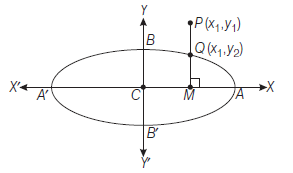
Since, \(Q\left(x_1, y_2\right)\) lies on the ellipse
\(
\frac{x^2}{a^2}+\frac{y^2}{b^2}=1
\)
\(
\text { then, } \quad \frac{x_1^2}{a^2}+\frac{y_2^2}{b^2}=1
\)
\(
\Rightarrow \quad \frac{y_2^2}{b^2}=1-\frac{x_1^2}{a^2} \dots(i)
\)
Now, point \(P\) lies outside, on or inside the ellipse according as
\(
P M>,=\text { or, } \angle Q M
\)
\(
\begin{array}{ll}
\Rightarrow & y_1>,=\text { or },<y_2 \\
\Rightarrow & \frac{y_1^2}{b^2}>,=\text { or },<\frac{y_2^2}{b^2}
\end{array}
\)
\(
\Rightarrow \quad \frac{y_1^2}{b^2}>,=\text { or, }<1-\frac{x_1^2}{a^2} \quad \text { [from Eq. (i)] }
\)
\(
\begin{array}{ll}
\Rightarrow & \frac{x_1^2}{a^2}+\frac{y_1^2}{b^2}>,=\text { or },<1, \\
\text { or } & \frac{x_1^2}{a^2}+\frac{y_1^2}{b^2}-1>,=\text { or },<0
\end{array}
\)
Hence, the point \(P\left(x_1, y_1\right)\) lies outside, on or inside the ellipse \(\frac{x^2}{a^2}+\frac{y^2}{b^2}=1\) according as
\(
\frac{x_1^2}{a^2}+\frac{y_1^2}{b^2}-1>0,=\text { or },<0
\)
Remark
- Let \(S=\frac{x^2}{a^2}+\frac{y^2}{b^2}-1\), then \(S_1=\frac{x_1^2}{a^2}+\frac{y_1^2}{b^2}-1\)
The point \(\left(x_1, y_1\right)\) lies outside, on or inside the ellipse \(S=0\) according as \(S_1>=\) or \(<0\).
Example 22: Find the position of the point \((4,-3)\) relative to the ellipse \(5 x^2+7 y^2=140\).
Answer: The given ellipse can be written as \(\quad \frac{x^2}{28}+\frac{y^2}{20}-1=0\)
Let \(\quad S=\frac{x^2}{28}+\frac{y^2}{20}-1\)
\(
\therefore \quad S_1=\frac{(4)^2}{28}+\frac{(-3)^2}{20}-1=\frac{3}{140}>0
\)
So, the point \((4,-3)\) lies outside the ellipse \(5 x^2+7 y^2=140\).
Example 23: Find the integral value of \(\alpha\) for which the point \(\left(7-\frac{5 \alpha}{4},-\alpha\right)\) lies inside the ellipse \(\frac{x^2}{25}+\frac{y^2}{16}=1\).
Answer: Since, the point \(\left(7-\frac{5 \alpha}{4},-\alpha\right)\) lies inside the ellipse
\(
\begin{aligned}
& \frac{x^2}{25}+\frac{y^2}{16}=1 \text {, then } \frac{1}{25}\left(7-\frac{5 \alpha}{4}\right)^2+\frac{1}{16}(-\alpha)^2-1<0 \\
& \Rightarrow \quad(28-5 \alpha)^2+25 \alpha^2-400<0 \\
& \Rightarrow \quad 50 \alpha^2-280 \alpha+384<0 \\
& \Rightarrow \quad 25 \alpha^2-140 \alpha+192<0 \\
& \Rightarrow \quad(5 \alpha-12)(5 \alpha-16)<0 \\
& \therefore \quad \frac{12}{5}<\alpha<\frac{16}{5} \\
&
\end{aligned}
\)
Hence, integral value of \(\alpha\) is 3.
Intersection of a Line and an Ellipse
Let the ellipse be \(\frac{x^2}{a^2}+\frac{y^2}{b^2}=1 \dots(i)\)
and the given line be \(\quad y=m x+c \dots(ii)\)
Eliminating \(y\) from Eqs. (i) and (ii), then
\(
\begin{gathered}
\frac{x^2}{a^2}+\frac{(m x+c)^2}{b^2}=1 \\
\Rightarrow \quad\left(a^2 m^2+b^2\right) x^2+2 m c a^2 x+c^2 a^2-a^2 b^2=0 \dots(iii)
\end{gathered}
\)
Above equation being a quadratic in \(x\) gives two values of \(x\). Shows that every straight line will cut the ellipse in two points may be real, coincident or imaginary according as
Discriminant of Eq. (iii) \(>,=,<0\)
i.e. \(\quad 4 m^2 c^2 a^4-4\left(a^2 m^2+b^2\right)\left(c^2 a^2-a^2 b^2\right)>,=,<0\)
or \(-a^2 b^2 c^2+a^4 b^2 m^2+a^2 b^4>,=,<0\)
or \(\quad a^2 m^2+b^2>,=,<c^2 \dots(iv)\)
Condition of Tangency : If the line Eq. (ii) touches the ellipse Eq. (i), then Eq. (iii) has equal roots.
\(\therefore\) Discriminant of Eq. (iii) \(=0\)
\(\Rightarrow \quad c^2=a^2 m^2+b^2 \quad\) or \(\quad c= \pm \sqrt{\left(a^2 m^2+b^2\right)} \dots(v)\)
so, the line \(y=m x+c\) touches the ellipse
\(
\frac{x^2}{a^2}+\frac{y^2}{b^2}=1 \quad \text { if } \quad c^2=a^2 m^2+b^2 \text { (which is condition of tangency) }
\)
Substituting the value of \(c\) from Eq. (v) in Eq. (ii), then
\(
y=m x \pm \sqrt{\left(a^2 m^2+b^2\right)}
\)
Hence, the lines \(y=m x \pm \sqrt{\left(a^2 m^2+b^2\right)}\) will always tangents to the ellipse.
Point of contact : Substituting \(c= \pm \sqrt{\left(a^2 m^2+b^2\right)}\) in Eq. (iii), then
\(
\begin{aligned}
& \left(a^2 m^2+b^2\right) x^2 \pm 2 m a^2 x \\
& \sqrt{\left(a^2 m^2+b^2\right)}+\left(a^2 m^2+b^2\right) a^2-a^2 b^2=0
\end{aligned}
\)
\(
\text { or } \quad\left(a^2 m^2+b^2\right) x^2 \pm 2 m a^2 x \sqrt{\left(a^2 m^2+b^2\right)}+a^4 m^2=0
\)
\(
\text { or } \quad\left(x \sqrt{\left(a^2 m^2+b^2\right)} \pm a^2 m\right)^2=0
\)
\(
\therefore \quad x= \pm \frac{a^2 m}{\sqrt{\left(a^2 m^2+b^2\right)}}= \pm \frac{a^2 m}{c}
\)
From Eq. (i), \(\quad \frac{a^4 m^2}{c^2} \cdot \frac{1}{a^2}+\frac{y^2}{b^2}=1\)
\(
\Rightarrow \quad \frac{y^2}{b^2}=1-\frac{a^2 m^2}{c^2}=\frac{c^2-a^2 m^2}{c^2}=\frac{b^2}{c^2}
\)
\(
y= \pm \frac{b^2}{c}
\)
Hence, the point of contact is \(\left( \pm \frac{a^2 m}{c}, \pm \frac{b^2}{c}\right)\) this known as m-point on the ellipse.
Remark
- If \(m=0\), then Eq. (iii) gives \(b^2 x^2+c^2 a^2-a^2 b^2=0\)
\(
\begin{aligned}
\text { or } b^2 x^2+\left(a^2 m^2+b^2\right) a^2-a^2 b^2 & =0 \\
x & = \pm \frac{a^2 m}{b}
\end{aligned}
\)
which gives two values of \(x\).
Example 24: Prove that the straight line
\(l x+m y+n=0\) touches the ellipse \(\frac{x^2}{a^2}+\frac{y^2}{b^2}=1\) if \(a^2 l^2+b^2 m^2=n^2\).
Answer: The given line is
\(
\begin{aligned}
& l x+m y+n=0 \\
& y=-\frac{l}{m} x-\frac{n}{m} \dots(i)
\end{aligned}
\)
Comparing this line with \(y=M x+c\)
\(
\therefore \quad M=-\frac{l}{m} \text { and } \quad c=-\frac{n}{m}
\)
The line Eq. (i) will touch the ellipse \(\frac{x^2}{a^2}+\frac{y^2}{b^2}=1\) if
\(
\begin{gathered}
c^2=a^2 M^2+b^2 \\
\frac{n^2}{m^2}=\frac{a^2 l^2}{m^2}+b^2 \\
a^2 l^2+b^2 m^2=n^2
\end{gathered}
\)
Example 25: Show that the line \(x \cos \alpha+y \sin \alpha=p\) touches the ellipse \(\frac{x^2}{a^2}+\frac{y^2}{b^2}=1\) if \(a^2 \cos ^2 \alpha+b^2 \sin ^2 \alpha=p^2\) and that point of contact is \(\left(\frac{a^2 \cos \alpha}{p}, \frac{b^2 \sin \alpha}{p}\right)\).
Answer: The given line is \(x \cos \alpha+y \sin \alpha=p\)
\(
y=-x \cot \alpha+p \operatorname{cosec} \alpha
\)
Comparing this line with \(y=m x+c\)
\(\therefore \quad m=-\cot \alpha\) and \(c=p \operatorname{cosec} \alpha\)
Hence, the given line touches the ellipse, then
\(
\begin{array}{rlrl}
c^2 & =a^2 m^2+b^2 \\
\Rightarrow & p^2 \operatorname{cosec}^2 \alpha =a^2 \cot ^2 \alpha+b^2 \\
\Rightarrow & p^2 =a^2 \cos ^2 \alpha+b^2 \sin ^2 \alpha
\end{array}
\)
and point of contact is \(\left(-\frac{a^2 m}{c}, \frac{b^2}{c}\right)\)
i.e. \(\quad\left(-\frac{a^2(-\cot \alpha)}{p \operatorname{cosec} \alpha}, \frac{b^2}{p \operatorname{cosec} \alpha}\right)\)
i.e. \(\left(\frac{a^2 \cos \alpha}{p}, \frac{b^2 \sin \alpha}{p}\right)\)
Example 26: For what value of \(\lambda\) does the line \(y=x+\lambda\) touches the ellipse \(9 x^2+16 y^2=144\).
Answer: Equation of ellipse is
\(
9 x^2+16 y^2=144 \text { or } \frac{x^2}{16}+\frac{y^2}{9}=1
\)
Comparing this with \(\quad \frac{x^2}{a^2}+\frac{y^2}{b^2}=1\) then, we get \(a^2=16\) and \(b^2=9\)
and comparing the line \(y=x+\lambda\) with \(y=m x+c\)
\(
\begin{array}{rlrl}
\therefore & m & =1 \\
\text { and } & c =\lambda
\end{array}
\)
If the line \(y=x+\lambda\) touches the ellipse
\(
\begin{aligned}
& 9 x^2+16 y^2=144 \\
& \text { then } \quad c^2=a^2 m^2+b^2 \\
& \Rightarrow \quad \lambda^2=16 \times 1^2+9 \\
& \Rightarrow \quad \lambda^2=25 \\
& \therefore \quad \lambda= \pm 5 \\
&
\end{aligned}
\)
Equation of Tangent in Different Forms
Case I: Point Form
Theorem : The equation of tangent to the ellipse \(\frac{x^2}{a^2}+\frac{y^2}{b^2}=1\) at the point \(\left(x_1, y_1\right)\) is \(\frac{x x_1}{a^2}+\frac{y y_1}{b^2}=1\)
Proof : (By first Principal Method)
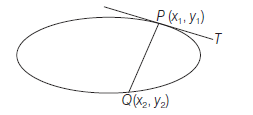
\(\because\) Equation of ellipse is \(\frac{x^2}{a^2}+\frac{y^2}{b^2}=1 \dots(i)\)
Let \(P \equiv\left(x_1, y_1\right)\) and \(Q \equiv\left(x_2, y_2\right)\) be any two point on Eq. (i), then
\(
\begin{aligned}
& \frac{x_1^2}{a^2}+\frac{y_1^2}{b^2}=1 \dots(ii)\\
& \text { and } \quad \frac{x_2^2}{a^2}+\frac{y_2^2}{b^2}=1 \dots(iii)
\end{aligned}
\)
Subtracting Eqs. (ii) from (iii), then
\(
\begin{array}{rlrl}
& \frac{1}{a^2}\left(x_2^2-x_1^2\right)+\frac{1}{b^2}\left(y_2^2-y_1^2\right)=0 \\
\Rightarrow & \frac{\left(x_2+x_1\right)\left(x_2-x_1\right)}{a^2}+\frac{\left(y_2+y_1\right)\left(y_2-y_1\right)}{b^2} =0 \\
\Rightarrow & \frac{y_2-y_1}{x_2-x_1}=-\frac{b^2\left(x_1+x_2\right)}{a^2\left(y_1+y_2\right)} \dots(iv)
\end{array}
\)
Equation of \(P Q\) is
\(
y-y_1=\frac{y_2-y_1}{x_2-x_1}\left(x-x_1\right) \dots(v)
\)
From Eqs. (iv) and (v), then
\(
y-y_1=-\frac{b^2\left(x_1+x_2\right)}{a^2\left(y_1+y_2\right)}\left(x-x_1\right) \dots(vi)
\)
Now, for tangent at \(P, Q \rightarrow P\) i.e., \(x_2 \rightarrow x_1\) and \(y_2 \rightarrow y_1\), then Eq. (vi) becomes
\(
\begin{aligned}
& y-y_1=-\frac{b^2\left(2 x_1\right)}{a^2\left(2 y_1\right)}\left(x-x_1\right) \\
& \text { or } \quad \frac{y y_1-y_1^2}{b^2}=-\left(\frac{x x_1-x_1^2}{a^2}\right) \\
&
\end{aligned}
\)
or \(\quad \frac{x x_1}{a^2}+\frac{y y_1}{b^2}=\frac{x_1^2}{a^2}+\frac{y_1^2}{b^2}\) or \(\frac{x x_1}{a^2}+\frac{y y_1}{b^2}=1 \quad\) [from (ii)]
which is required equation of tangent at \(\left(x_1, y_1\right)\).
Remark
- The equation of tangent at \(\left(x_1, y_1\right)\) can be obtained by replacing \(x^2\) by \(x x_1, y^2\) by \(y y_1, x\) by \(\frac{x+x_1}{2}, y\) by \(\frac{y+y_1}{2}\) and \(x y\) by \(\frac{x y_1+x_1 y}{2}\)
This method is applicable only when the equation of ellipse is a polynomial of second degree in \(x\) and \(y\).
Case II: Parametric form
Theorem : The equation of tangent to the ellipse \(\frac{x^2}{a^2}+\frac{y^2}{b^2}=1\) at the point \((a \cos \phi, b \sin \phi)\) is
\(
\frac{x}{a} \cos \phi+\frac{y}{b} \sin \phi=1
\)
Proof: The equation of tangent to the ellipse \(\frac{x^2}{a^2}+\frac{y^2}{b^2}=1\) at the point \(\left(x_1, y_1\right)\) is \(\frac{x x_1}{a^2}+\frac{y y_1}{b^2}=1\)
(by point form)
Replacing \(x_1\) by \(a \cos \phi\) and \(y_1\) by \(b \sin \phi\), then we get
\(
\frac{x}{a} \cos \phi+\frac{y}{b} \sin \phi=1
\)
Remark
- Point of intersection of tangent at ‘ \(\theta\) ‘ and ‘ \(\phi\) ‘ on the ellipse
\(
\frac{x^2}{a^2}+\frac{y^2}{b^2}=1 \text { is }\left(\frac{a \cos \left(\frac{\theta+\phi}{2}\right)}{\cos \left(\frac{\theta-\phi}{2}\right)}, \frac{b \sin \left(\frac{\theta+\phi}{2}\right)}{\cos \left(\frac{\theta-\phi}{2}\right)}\right)
\)
Case III: Slope form
Theorem : The equations of tangents of slope \(m\) to ellipse \(\frac{x^2}{a^2}+\frac{y^2}{b^2}=1\) are \(y=m x \pm \sqrt{\left(a^2 m^2+b^2\right)}\) and the coordinates of the points of contact are
\(
\left(\mp \frac{a^2 m}{\sqrt{\left(a^2 m^2+b^2\right)}}, \pm \frac{b^2}{\sqrt{\left(a^2 m^2+b^2\right)}}\right)
\)
Proof : Let \(y=m x+c\) be a tangent to the ellipse
\(
\frac{x^2}{a^2}+\frac{y^2}{b^2}=1 \text {. }
\)
Then the equation \(\frac{x^2}{a^2}+\frac{(m x+c)^2}{b^2}=1\)
\(
\Rightarrow \quad x^2\left(a^2 m^2+b^2\right)+2 a^2 m c x+a^2\left(c^2-b^2\right)=0 \dots(i)
\)
must have equal roots
\(
4 a^4 m^2 c^2-4\left(a^2 m^2+b^2\right) a^2\left(c^2-b^2\right)=0 \left\{\because B^2-4 A C=0\right\}
\)
\(
\begin{array}{lr}
\Rightarrow & a^2 m^2 c^2-\left(a^2 m^2+b^2\right)\left(c^2-b^2\right)=0 \\
\Rightarrow & a^2 m^2 c^2-a^2 m^2 c^2+a^2 b^2 m^2-b^2 c^2+b^4=0 \\
\Rightarrow & a^2 b^2 m^2-b^2 c^2+b^4=0 \\
\Rightarrow & c^2=a^2 m^2+b^2 \\
\therefore & c= \pm \sqrt{\left(a^2 m^2+b^2\right)}
\end{array}
\)
as the required equations of tangent of ellipse in terms of slope, putting \(c= \pm \sqrt{\left(a^2 m^2+b^2\right)}\) in (i), we get
\(
\begin{array}{cc}
& x^2\left(a^2 m^2+b^2\right) \pm 2 a^2 m \sqrt{\left(a^2 m^2+b^2\right)} x+a^4 m^2=0 \\
\Rightarrow & \left(\sqrt{\left(a^2 m^2+b^2\right)} x \pm a^2 m\right)^2=0 \\
\Rightarrow & x=\mp \frac{a^2 m}{\sqrt{\left(a^2 m^2+b^2\right)}}
\end{array}
\)
Substituting this value of \(x\) in
\(
y=m x \pm \sqrt{a^2 m^2+b^2}
\)
we obtained
\(
y= \pm \frac{b^2}{\sqrt{\left(a^2 m^2+b^2\right)}}
\)
Thus, the coordinates of the points of contact are
\(
\left(\mp \frac{a^2 m}{\sqrt{\left(a^2 m^2+b^2\right)}}, \pm \frac{b^2}{\sqrt{\left(a^2 m^2+b^2\right)}}\right)
\)
Example 27: If the line \(3 x+4 y=\sqrt{7}\) touches the ellipse \(3 x^2+4 y^2=1\), then find the point of contact.
Answer: Let the given line touches the ellipse at point \(P\left(x_1, y_1\right)\). The equation of tangent at \(P\) is
\(
3 x x_1+4 y y_1=1
\)
Comparing Eq. (i) with the given equation of line \(3 x+4 y=\sqrt{7}\), we get
\(
\frac{3 x_1}{3}=\frac{4 y_1}{4}=\frac{1}{\sqrt{7}}
\)
\(\therefore \quad x_1=y_1=\frac{1}{\sqrt{7}}\)
Hence, point of contact \(\left(x_1, y_1\right)\) is \(\left(\frac{1}{\sqrt{7}}, \frac{1}{\sqrt{7}}\right)\).
Example 28: Find the equations of the tangents to the ellipse \(3 x^2+4 y^2=12\) which are perpendicular to the line \(y+2 x=4\).
Answer: Let \(m\) be the slope of the tangent, since the tangent is perpendicular to the line \(y+2 x=4\).
\(
\begin{array}{lr}
\therefore & m \times-2=-1 \\
\Rightarrow & m=\frac{1}{2} \\
\text { Since } & 3 x^2+4 y^2=12
\end{array}
\)
\(
\text { or } \quad \frac{x^2}{4}+\frac{y^2}{3}=1
\)
\(
\begin{aligned}
& \text { Comparing this with } & \frac{x^2}{a^2}+\frac{y^2}{b^2} & =1 \\
& \therefore a^2 =4 \\
& \text { and } b^2 =3
\end{aligned}
\)
So the equations of the tangents are
\(
\begin{aligned}
& y=\frac{1}{2} x \pm \sqrt{4 \times \frac{1}{4}+3} \\
\Rightarrow & y=\frac{1}{2} x \pm 2 \\
\text { or } & x -2 y \pm 4=0
\end{aligned}
\)
Example 29: Find the locus of the foot of the perpendicular drawn from centre upon any tangent to the ellipse \(\frac{x^2}{a^2}+\frac{y^2}{b^2}=1\).
Answer: Any tangent of \(\frac{x^2}{a^2}+\frac{y^2}{b^2}=1\) is
\(
y=m x+\sqrt{\left(a^2 m^2+b^2\right)} \dots(i)
\)
Equation of the line perpendicular to Eq. (i) and passing through \((0,0)\) is
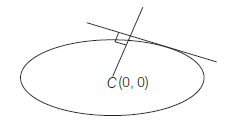
\(
y=-\frac{1}{m} x \text { or } m=-\frac{x}{y} \dots(ii)
\)
Substituting the value of \(m\) from Eq. (ii) in Eq. (i), then
\(
\begin{aligned}
y & =-\frac{x^2}{y}+\sqrt{\left(a^2 \frac{x^2}{y^2}+b^2\right)} \\
\Rightarrow \quad\left(x^2+y^2\right)^2 & =a^2 x^2+b^2 y^2
\end{aligned}
\)
or changing to polars by putting \(x=r \cos \theta, y=r \sin \theta\) it becomes
\(
r^2=a^2 \cos ^2 \theta+b^2 \sin ^2 \theta
\)
Example 30: Find the point on the ellipse \(16 x^2+11 y^2=256\), where the common tangent to it and the circle \(x^2+y^2-2 x=15\) touch.
Answer: The given ellipse is \(\frac{x^2}{16}+\frac{y^2}{(256 / 11)}=1\)
Equation of tangent to it at point \(\left(4 \cos \theta, \frac{16}{\sqrt{11}} \sin \theta\right)\) is
\(
\frac{x}{4} \cos \theta+y \frac{\sqrt{11}}{16} \sin \theta=1
\)
It also touch the circle \((x-1)^2+(y-0)^2=4^2\)
Therefore,
\(
\begin{aligned}
& \frac{\left|\frac{1}{4} \cos \theta-1\right|}{\sqrt{\left(\frac{\cos ^2 \theta}{16}+\frac{11}{256} \sin ^2 \theta\right)}}=4 \\
\Rightarrow \quad & |\cos \theta-4|=\sqrt{\left(16 \cos ^2 \theta+11 \sin ^2 \theta\right)}
\end{aligned}
\)
or \(4 \cos ^2 \theta+8 \cos \theta-5=0\)
or \(\quad(2 \cos \theta-1)(2 \cos \theta+5)=0\)
\(
\text { or} \cos \theta=\frac{1}{2} \quad\left(\because \cos \theta \neq-\frac{5}{2}\right)
\)
\(\therefore \quad \theta=\frac{\pi}{3}, \frac{5 \pi}{3}\)
Therefore, points are \(\left(2, \pm \frac{8 \sqrt{3}}{11}\right)\)
Example 31: Find the maximum area of the ellipse \(\frac{x^2}{a^2}+\frac{y^2}{b^2}=1\) which touches the line \(y=3 x+2\)
Answer: Line \(y=3 x+2\) touches ellipse \(\frac{x^2}{a^2}+\frac{y^2}{b^2}=1\)
Here, \(\quad m=3\) and \(c=2\)
Substituting in \(c^2=a^2 m^2+b^2\)
or \(4=9 a^2+b^2 \dots(i)\)
Now, \(\quad A M \geq G M\)
\(
\Rightarrow \quad \frac{9 a^2+b^2}{2} \geq \sqrt{\left(9 a^2\right) b^2} \Rightarrow \frac{9 a^2+b^2}{2} \geq 3 a b
\)
\(
\begin{array}{lll}
\Rightarrow & 2 \geq 3 a b & \text { [from Eq. (i)] }
\end{array}
\)
\(
\begin{aligned}
&\begin{array}{ll}
\text { or } & \frac{2 \pi}{3} \geq \pi a b \\
\text { or } & \frac{2 \pi}{3} \geq \text { Area of ellipse }
\end{array}\\
&\text { Therefore, the maximum area of the ellipse is } \frac{2 \pi}{3} \text {. }
\end{aligned}
\)
Example 32: A circle of radius \(r\) is concentric with the ellipse \(\frac{x^2}{a^2}+\frac{y^2}{b^2}=1\). Prove that the common tangent is inclined to the major axis at an angle \(\tan ^{-1} \sqrt{\left(\frac{r^2-b^2}{a^2-r^2}\right)}\)
Answer: Equation of the circle of radius \(r\) and concentric with ellipse \(\frac{x^2}{a^2}+\frac{y^2}{b^2}=1\) is
\(
x^2+y^2=r^2 \dots(i)
\)
any tangent to ellipse \(\frac{x^2}{a^2}+\frac{y^2}{b^2}=1\) is
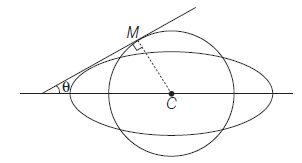
\(
y=m x+\sqrt{\left(a^2 m^2+b^2\right)} \quad(\text { where } m=\tan \theta)
\)
If it is a tangent to circle, then perpendicular from \((0,0)\) is equal to radius \(r\),
\(
\begin{array}{ll}
\therefore \quad & \frac{\sqrt{\left(a^2 m^2+b^2\right)}}{\sqrt{\left(m^2+1\right)}}=|r| \text { or } a^2 m^2+b^2=m^2 r^2+r^2 \\
& \left(a^2-r^2\right) m^2=r^2-b^2
\end{array}
\)
\(
\begin{aligned}
m & =\sqrt{\left(\frac{r^2-b^2}{a^2-r^2}\right)} \\
\tan \theta & =\sqrt{\left(\frac{r^2-b^2}{a^2-r^2}\right)} \\
\theta & =\tan ^{-1} \sqrt{\left(\frac{r^2-b^2}{a^2-r^2}\right)}
\end{aligned}
\)
Example 33: Show that the product of the perpendiculars from the foci of any tangent to an ellipse is equal to the square of the semi minor axis, and the feet of a these perpendiculars lie on the auxiliary circle.
Answer: Let equation of ellipse be
\(
\frac{x^2}{a^2}+\frac{y^2}{b^2}=1 \dots(i)
\)
Equation of any tangent in term of slope \(( m )\) of (i) is
\(
\begin{aligned}
y & =m x+\sqrt{\left(a^2 m^2+b^2\right)} \\
\text { or } \quad y-m x & =\sqrt{a^2 m^2+b^2} \dots(ii)
\end{aligned}
\)
Equation of a line perpendicular to Eq. (ii) and passing through \(S(a e, 0)\) is
\(
\begin{aligned}
y-0 & =-\frac{1}{m}(x-a e) \\
\text { or } \quad x+m y & =a e \dots(iii)
\end{aligned}
\)
The lines Eq. (ii) and Eq. (iii) will meet at the foot of perpendicular whose locus is obtained by eliminating the variable \(m\) between Eq. (ii) and Eq. (iii), then squaring and adding Eq. (ii) and Eq. (iii), we get
\(
\begin{aligned}
& (y-m x)^2+(x+m y)^2=a^2 m^2+b^2+a^2 e^2 \\
& \Rightarrow \quad\left(1+m^2\right)\left(x^2+y^2\right)=a^2 m^2+b^2+a^2-b^2 \\
& \Rightarrow \quad\left(1+m^2\right)\left(x^2+y^2\right)=a^2\left(1+m^2\right) \\
& \text { or } \quad x^2+y^2=a^2 \\
&
\end{aligned}
\)
which is auxiliary circle of ellipse, similarly we can show that the other foot drawn from second focus also lies on \(x^2+y^2=a^2\).
Again if \(p_1\) and \(p_2\) be perpendiculars from foci \(S(a e, 0)\) and \(S^{\prime}(-a e, 0)\) on (ii), then
\(
\begin{aligned}
& p_1=\frac{\left|\sqrt{\left(a^2 m^2+b^2\right)}+m a e\right|}{\sqrt{\left(1+m^2\right)}} \\
\text { and } & p_2=\frac{\left|\sqrt{\left(a^2 m^2+b^2\right)}-m a e\right|}{\sqrt{\left(1+m^2\right)}} \\
& \therefore \quad p_1 p_2=\frac{\left|a^2 m^2+b^2-a^2 e^2 m^2\right|}{\left(1+m^2\right)} \\
& =\frac{\left|a^2 m^2+b^2-\left(a^2-b^2\right) m^2\right|}{\left(1+m^2\right)} \\
& =\frac{b^2\left(1+m^2\right)}{\left(1+m^2\right)} \\
& =b^2=(\text { semi minor axis })^2 \\
&
\end{aligned}
\)
Example 34: Prove that the locus of mid-points of the portion of the tangents to the ellipse \(\frac{x^2}{a^2}+\frac{y^2}{b^2}=1\) intercepted between the axes is \(a^2 y^2+b^2 x^2=4 x^2 y^2\).
Answer: Let \(P\left(x_1, y_1\right)\) be any point on the ellipse
\(
\frac{x^2}{a^2}+\frac{y^2}{b^2}=1 \dots(i)
\)
\(\therefore\) Equation of tangent at \(\left(x_1, y_1\right)\) to (i) is \(\frac{x x_1}{a^2}+\frac{y y_1}{b^2}=1\)
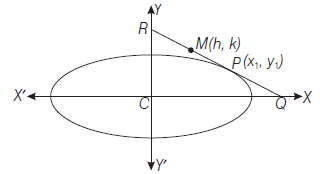
This meet the coordinate axes at
\(
Q\left(\frac{a^2}{x_1}, 0\right) \text { and } R\left(0, \frac{b^2}{y_1}\right)
\)
Let \(M(h, k)\) be the mid-point of \(Q R\) then,
\(
\begin{aligned}
\Rightarrow=\frac{\frac{a^2}{x_1}+0}{2}, k & =\frac{0+\frac{b^2}{y_1}}{2} \\
\Rightarrow \quad x_1 & =\frac{a^2}{2 h}, y_1=\frac{b^2}{2 k}
\end{aligned}
\)
Since, \(\left(x_1, y_1\right)\) lies on Eq. (i)
\(
\begin{array}{ll}
\therefore & \frac{\left(\frac{a^2}{2 h}\right)^2}{a^2}+\frac{\left(\frac{b^2}{2 k}\right)^2}{b^2}=1 \\
\Rightarrow & \frac{a^2}{4 h^2}+\frac{b^2}{4 k^2}=1 \\
\Rightarrow & a^2 k^2+b^2 h^2=4 h^2 k^2
\end{array}
\)
Hence, the locus of \(M(h, k)\) is \(a^2 y^2+b^2 x^2=4 x^2 y^2\)
Example 35: Prove that the tangents at the extremities of latusrectum of an ellipse intersect on the corresponding directrix.
Answer: Let \(L S L^{\prime}\) be a latusrectum of the ellipse \(\frac{x^2}{a^2}+\frac{y^2}{b^2}=1\).
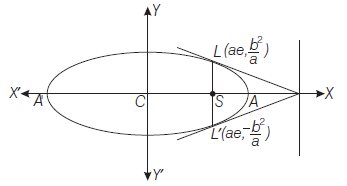
\(\therefore\) The coordinates of \(L\) and \(L^{\prime}\) are
\(
\left(a e, \frac{b^2}{a}\right) \text { and }\left(a e,-\frac{b^2}{a}\right) \text { respectively }
\)
\(\therefore\) Equation of tangent at \(L\left(a e, \frac{b^2}{a}\right)\) is
\(
\Rightarrow \quad \frac{x(a e)}{a^2}+\frac{y\left(\frac{b^2}{a}\right)}{b^2}=1
\)
\(
\Rightarrow \quad x e+y=a \dots(i)
\)
The equation of the tangent at \(L^{\prime}\left(a e,-\frac{b^2}{a}\right)\) is
\(
\begin{aligned}
& \frac{x(a e)}{a^2}+\frac{y\left(-\frac{b^2}{a}\right)}{b^2}=1 \\
& \Rightarrow \quad e x-y=a \dots(ii)\\
&
\end{aligned}
\)
Solving Eqs. (i) and (ii), we get
\(
x=\frac{a}{e} \text { and } y=0
\)
Thus, the tangents at \(L\) and \(L^{\prime}\) intersect at \((a / e, 0)\) which is a point lying on the corresponding directrix i.e. \(x=\frac{a}{e}\).
Equations of Normals in Different Forms
Case I: Point Form
Theorem : The equation of normal at \(\left(x_1, y_1\right)\) to the ellipse \(\frac{x^2}{a^2}+\frac{y^2}{b^2}=1\) is
\(
\frac{a^2 x}{x_1}-\frac{b^2 y}{y_1}=a^2-b^2
\)
Proof: Since the equation of tangent to the ellipse \(\frac{x^2}{a^2}+\frac{y^2}{b^2}=1\) at \(\left(x_1, y_1\right)\) is
\(
\frac{x x_1}{a^2}+\frac{y y_1}{b^2}=1
\)
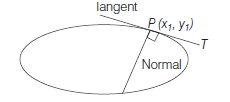
The slope of the tangent at \(\left(x_1, y_1\right)=-\frac{b^2 x_1}{a^2 y_1}\)
\(\therefore\) Slope of Normals at \(\left(x_1, y_1\right)=\frac{a^2 y_1}{b^2 x_1}\) Hence, the equation of normal at \(\left(x_1, y_1\right)\) is
\(
y-y_1=\frac{a^2 y_1}{b^2 x_1}\left(x-x_1\right)
\)
\(
\text { or } \quad \frac{a^2 x}{x_1}-\frac{b^2 y}{y_1}=a^2-b^2
\)
Case-II: Parametric form
Theorem : The equation of normal to the ellipse
\(
\begin{aligned}
\frac{x^2}{a^2}+\frac{y^2}{b^2} & =1 \text { at }(a \cos \phi, b \sin \phi) \text { is } \\
a x \sec \phi-b y \operatorname{cosec} \phi & =a^2-b^2
\end{aligned}
\)
Proof : Since, the equation of normal of the ellipse \(\frac{x^2}{a^2}+\frac{y^2}{b^2}=1\) at \(\left(x_1, y_1\right)\) is
\(
\frac{a^2 x}{x_1}-\frac{b^2 y}{y_1}=a^2-b^2 \dots(i)
\)
Replacing \(x_1\) by \(a \cos \phi\) and \(y_1\) by \(b \sin \phi\), then Eq.(i) becomes
\(
\begin{aligned}
\frac{a^2 x}{a \cos \phi}-\frac{b^2 y}{b \sin \phi} & =a^2-b^2 \\
a x \sec \phi-b y \operatorname{cosec} \phi & =a^2-b^2
\end{aligned}
\)
is the equation of normal at \((a \cos \phi, b \sin \phi)\)
Case-III: Slope form
Theorem : The equations of the normals of slope \(m\) to the ellipse \(\frac{x^2}{a^2}+\frac{y^2}{b^2}=1\) are given by
\(
y=m x \mp \frac{m\left(a^2-b^2\right)}{\sqrt{\left(a^2+b^2 m^2\right)}}
\)
at the points \(\left( \pm \frac{a^2}{\sqrt{\left(a^2+b^2 m^2\right)}}, \pm \frac{m b^2}{\sqrt{\left(a^2+b^2 m^2\right)}}\right)\).
Proof : The equation of normal to the ellipse \(\frac{x^2}{a^2}+\frac{y^2}{b^2}=1\) at \(\left(x_1, y_1\right)\) is
\(
\frac{a^2 x}{x_1}-\frac{b^2 y}{y_1}=a^2-b^2 \dots(i)
\)
Since, ‘ \(m\) ‘ is the slope of the normal, then
\(
\begin{gathered}
m=\frac{a^2 y_1}{b^2 x_1} \\
y_1=\frac{b^2 x_1 m}{a^2} \dots(ii)
\end{gathered}
\)
\(
\begin{aligned}
& \text { Since, }\left(x_1, y_1\right) \text { lies on } \frac{x^2}{a^2}+\frac{y^2}{b^2}=1 \\
& \therefore \quad \frac{x_1^2}{a^2}+\frac{y_1^2}{b^2}=1
\end{aligned}
\)
\(
\text { or } \quad \frac{x_1^2}{a^2}+\frac{b^4 x_1^2 m^2}{a^4 b^2}=1
\)
\(
\text { or } \quad \frac{x_1^2}{a^2}+\frac{b^2 x_1^2 m^2}{a^4}=1 \text { or } x_1^2=\frac{a^4}{\left(a^2+b^2 m^2\right)}
\)
\(
\therefore \quad x_1= \pm \frac{a^2}{\sqrt{a^2+b^2 m^2}}
\)
From Eq. (ii),
\(
y_1= \pm \frac{m b^2}{\sqrt{\left(a^2+b^2 m^2\right)}}
\)
\(\therefore\) Equation of normal in terms of slope is
\(
y-\left( \pm \frac{m b^2}{\sqrt{a^2+b^2 m^2}}\right)=m\left(x-\left( \pm \frac{a^2}{\sqrt{a^2+b^2 m^2}}\right)\right)
\)
\(
\Rightarrow \quad y=m x \mp \frac{m\left(a^2-b^2\right)}{\sqrt{\left(a^2+b^2 m^2\right)}} \dots(iii)
\)
Thus \(y=m x \pm \frac{m\left(a^2-b^2\right)}{\sqrt{\left(a^2+b^2 m^2\right)}}\) is a normal to the ellipse \(\frac{x^2}{a^2}+\frac{y^2}{b^2}=1\), where \(m\) is the slope of the normal.
The coordinates of the point of contact are
\(
\left( \pm \frac{a^2}{\sqrt{a^2+b^2 m^2}}, \pm \frac{m b^2}{\sqrt{a^2+b^2 m^2}}\right)
\)
Comparing Eq. (iii) with,
\(
\begin{aligned}
& y=m x+c \\
& \therefore \quad c=\mp \frac{m\left(a^2-b^2\right)}{\sqrt{\left(a^2+b^2 m^2\right)}} \\
& \text { or } \quad c^2=\frac{m^2\left(a^2-b^2\right)^2}{\left(a^2+b^2 m^2\right)} \\
&
\end{aligned}
\)
which is condition of normality, when \(y=m x+c\) is the normal of
\(
\frac{x^2}{a^2}+\frac{y^2}{b^2}=1
\)
Example 36: If the normal at an end of \(a\) latusrectum of an ellipse \(\frac{x^2}{a^2}+\frac{y^2}{b^2}=1\) passes through one extremity of the minor axis, show that the eccentricity of the ellipse is given by
\(
e^4+e^2-1=0 \text { or } e^2=\frac{\sqrt{5}-1}{2}
\)
Answer: The coordinates of an end of the latusrectum are \(\left(a e, b^2 / a\right)\). The equation of normal at \(P\left(a e, b^2 / a\right)\) is
\(
\begin{gathered}
\frac{a^2 x}{a e}-\frac{b^2(y)}{b^2 / a}=a^2-b^2 \\
\frac{a x}{e}-a y=a^2-b^2
\end{gathered}
\)
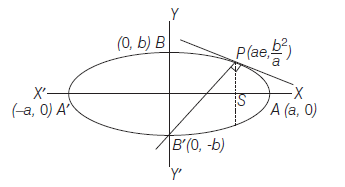
It passes through one extremity of the minor axis whose coordinates are \((0,-b)\)
\(
\therefore \quad 0+a b=a^2-b^2
\)
or \(\left(a^2 b^2\right)=\left(a^2-b^2\right)^2\)
or \(a^2 a^2\left(1-e^2\right)=\left(a^2 e^2\right)^2\)
or \(1-e^2=e^4\)
or \(e^4+e^2-1=0\)
or \(\left(e^2\right)^2+e^2-1=0\)
\(
\begin{array}{lll}
\therefore & e^2=\frac{-1 \pm \sqrt{1+4}}{2} \\
\Rightarrow & e^2=\frac{\sqrt{5}-1}{2} & \text { (taking + ve sign) }
\end{array}
\)
Example 37: Prove that the straight line \(l x+m y+n=0\) is a normal to the ellipse \(\frac{x^2}{a^2}+\frac{y^2}{b^2}=1\) if \(\frac{a^2}{l^2}+\frac{b^2}{m^2}=\frac{\left(a^2-b^2\right)^2}{n^2}\).
Answer: The equation of any normal to \(\frac{x^2}{a^2}+\frac{y^2}{b^2}=1\) is
\(a x \sec \phi-b y \operatorname{cosec} \phi=a^2-b^2 \dots(i)\)
The straight line \(l x+m y+n=0\) will be a normal to the ellipse \(\frac{x^2}{a^2}+\frac{y^2}{b^2}=1\)
Therefore, Eq. (i) and \(l x+m y+n=0\) represent the same line
\(
\begin{aligned}
\frac{a \sec \phi}{l} & =\frac{-b \operatorname{cosec} \phi}{m}=\frac{a^2-b^2}{-n} \\
\cos \phi & =\frac{-n a}{l\left(a^2-b^2\right)}
\end{aligned}
\)
\(
\text { and } \sin \phi=\frac{n b}{m\left(a^2-b^2\right)}
\)
\(
\begin{array}{lr}
\because & \sin ^2 \phi+\cos ^2 \phi=1 \\
\therefore & \frac{n^2 b^2}{m^2\left(a^2-b^2\right)^2}+\frac{n^2 a^2}{l^2\left(a^2-b^2\right)^2}=1
\end{array}
\)
\(
\Rightarrow \quad \frac{a^2}{l^2}+\frac{b^2}{m^2}=\frac{\left(a^2-b^2\right)^2}{n^2}
\)
Example 38: \(A\) normal inclined at an angle of \(45^{\circ}\) to \(x\)-axis of the ellipse \(\frac{x^2}{a^2}+\frac{y^2}{b^2}=1\) is drawn. It meets the major and minor axes in \(P\) and \(Q\) respectively. If \(C\) is the centre of the ellipse, prove that area of \(\triangle C P Q\) is \(\frac{\left(a^2-b^2\right)^2}{2\left(a^2+b^2\right)}\) sq units.
Answer: Let \(R(a \cos \phi, b \sin \phi)\) be any point on the ellipse, then equation of normal at \(R\) is
\(
a x \sec \phi-b y \operatorname{cosec} \phi=a^2-b^2
\)
or \(\frac{x}{\frac{\cos \phi\left(a^2-b^2\right)}{a}}+\frac{y}{\frac{-\sin \phi\left(a^2-b^2\right)}{b}}=1\)
If meets the major and minor axes at \(P\left(\frac{\left(a^2-b^2\right)}{a} \cos \phi, 0\right)\) and \(Q\left(0,-\frac{\left(a^2-b^2\right)}{b} \sin \phi\right)\) are respectively
\(\therefore \quad C P=\left(\frac{a^2-b^2}{a}\right)|\cos \phi|\)
\(
\text { and } C Q=\left(\frac{a^2-b^2}{b}\right)|\sin \phi|
\)
\(
\begin{aligned}
\therefore \text { Area of } \triangle C P Q & =\frac{1}{2} \times C P \times C Q \\
& =\frac{\left(a^2-b^2\right)^2|\sin \phi \cos \phi|}{2 a b} \dots(i)
\end{aligned}
\)
But slope of normal \(=\frac{a}{b} \tan \phi=\tan 45^{\circ} \text { given }\)
\(
\begin{aligned}
\frac{a}{b} \tan \phi & =1 \\
\tan \phi & =\frac{b}{a} \\
\sin 2 \phi & =\frac{2 \tan \phi}{1+\tan ^2 \phi}=\frac{2 a b}{a^2+b^2}
\end{aligned}
\)
\(
\therefore \text { From Eq. (i), Area of } \triangle C P Q=\frac{\left(a^2-b^2\right)^2\left|\frac{\sin 2 \phi}{2}\right|}{2 a b}
\)
\(
\begin{aligned}
& =\frac{\left(a^2-b^2\right)^2 \frac{a b}{\left(a^2+b^2\right)}}{2 a b} \\
& =\frac{\left(a^2-b^2\right)^2}{2\left(a^2+b^2\right)} \text { sq units. }
\end{aligned}
\)
Example 39: Any ordinate \(M P\) of an ellipse meets the auxiliary circle in Q. Prove that the locus of the point of intersection of the normals at \(P\) and \(Q\) is the circle \(x^2+y^2=\left(a^2+b^2\right)^2\).
Answer: Let equation of ellipse is \(\frac{x^2}{a^2}+\frac{y^2}{b^2}=1\) its auxiliary circle is
\(
x^2+y^2=a^2
\)
Coordinates of \(P\) and \(Q\) are \((a \cos \phi, b \sin \phi)\) and \((a \cos \phi, a \sin \phi)\) respectively. Equation of normal at \(P\) to the ellipse \(\frac{x^2}{a^2}+\frac{y^2}{b^2}=1\) is
\(
a x \sec \phi-b y \operatorname{cosec} \phi=a^2-b^2
\)
and equation of normal at \(Q\) to the circle \(x^2+y^2=a^2\) is
\(
\begin{aligned}
& \qquad y=x \tan \phi \dots(ii)\\
& \text { From Eq. (ii), } \quad \tan \phi=\frac{y}{x}
\end{aligned}
\)
\(
\begin{aligned}
& \text { From Eq. (ii), } \tan \phi=\frac{y}{x} \\
& \therefore \quad \sin \phi=\frac{y}{\sqrt{\left(x^2+y^2\right)}} \text { and } \cos \phi=\frac{x}{\sqrt{\left(x^2+y^2\right)}} \\
& \text { or } \quad \operatorname{cosec} \phi=\frac{\sqrt{\left(x^2+y^2\right)}}{y} \\
& \text { and } \quad \sec \phi=\frac{\sqrt{\left(x^2+y^2\right)}}{x} \dots(iii)
\end{aligned}
\)
Substituting the values of \(\sec \phi\) and \(\operatorname{cosec} \phi\) from Eq. (iii) in Eq. (i)
\(
\therefore \quad a x \times \frac{\sqrt{\left(x^2+y^2\right)}}{x}-b y \times \frac{\sqrt{\left(x^2+y^2\right)}}{y}=a^2-b^2
\)
\(
\begin{aligned}
(a-b) \sqrt{\left(x^2+y^2\right)} & =(a+b)(a-b) \\
\sqrt{x^2+y^2} & =a+b \\
x^2+y^2 & =(a+b)^2
\end{aligned}
\)
which is required locus.
Properties of Eccentric Angles of the Co-normal Points
Case 1: In general, four normals can be drawn to an ellipse from any point and if \(\alpha, \beta, \gamma, \delta\) the eccentric angles of these four co-normal points, then \(\alpha+\beta+\gamma+\delta\) is an odd multiple of \(\pi\).
Let \(Q(h, k)\) be any given point and let \(P(a \cos \phi, b \sin \phi)\) be any point on the ellipse
\(
\frac{x^2}{a^2}+\frac{y^2}{b^2}=1
\)
Equation of normal at \(P(a \cos \phi, b \sin \phi)\) is
\(
a x \sec \phi-b y \operatorname{cosec} \phi=a^2-b^2
\)
\(
\begin{aligned}
& \text { it passes through } Q(h, k) \\
& \therefore \quad a h \sec \phi-b k \operatorname{cosec} \phi=a^2-b^2 \\
& \text { or } \quad \frac{a h}{\cos \phi}-\frac{b k}{\sin \phi}=a^2-b^2 \dots(i)
\end{aligned}
\)
\(
\text { or } \frac{a h}{\left(\frac{1-\tan ^2(\phi / 2)}{1+\tan ^2(\phi / 2)}\right)}-\frac{b k}{\left(\frac{2 \tan (\phi / 2)}{1+\tan ^2(\phi / 2)}\right)}=a^2-b^2 \dots(ii)
\)
Let \(\quad \tan \phi / 2=t\) then, Eq. (ii) reduced to
\(
\begin{aligned}
& b k t^4+2\left\{a h+\left(a^2-b^2\right)\right\} t^3+2 \\
&\left\{a h-\left(a^2-b^2\right)\right\} t-b k=0 \dots(iii)
\end{aligned}
\)
Which is a fourth degree equation in \(t\), hence four normals can be drawn to an ellipse from any point.
Consequently, it has four values of \(\phi\) say \(\alpha, \beta, \gamma, \delta\) \((\because t=\tan \phi / 2)\).
Now, \(\quad \tan \left(\frac{\alpha}{2}+\frac{\beta}{2}+\frac{\gamma}{2}+\frac{\delta}{2}\right)=\frac{S_1-S_3}{1-S_2+S_4}\)
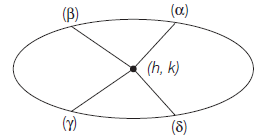
\(
\begin{aligned}
& =\frac{\frac{-2\left\{a h+\left(a^2-b^2\right)\right\}}{b k}+\frac{2\left\{\left(a h-\left(a^2-b^2\right)\right\}\right.}{b k}}{1-0-1} \\
& =\infty \quad \text { (From trigonometry) } \quad(\because a \neq b) \\
& \text { or } \quad \cot \left(\frac{\alpha}{2}+\frac{\beta}{2}+\frac{\gamma}{2}+\frac{\delta}{2}\right)=0 \\
& \text { or } \quad \frac{\alpha}{2}+\frac{\beta}{2}+\frac{\gamma}{2}+\frac{\delta}{2}=\text { an odd multiple of } \pi / 2 \\
& \Rightarrow \quad \alpha+\beta+\gamma+\delta=\text { an odd multiple of } \pi \\
&
\end{aligned}
\)
Case 2: If \(\alpha, \beta, \gamma\) are the eccentric angles of three points on the ellipse \(\frac{x^2}{a^2}+\frac{y^2}{b^2}=1\), the normals at which are concurrent, then
\(
\sin (\alpha+\beta)+\sin (\beta+\gamma)+\sin (\gamma+\alpha)=0
\)
\(
\begin{aligned}
& \text { From Eq. (iii), } \quad \Sigma t_1 t_2=0 \dots(iv)\\
& \text { and } \quad t_1 t_2 t_3 t_4=-1 \dots(v)\\
& \text { Now, } \quad \Sigma t_1 t_2=0 \\
&
\end{aligned}
\)
\(
\begin{aligned}
& \Rightarrow \quad t_1 t_2+t_2 t_3+t_3 t_1=-t_4\left(t_1+t_2+t_3\right) \\
& \Rightarrow \quad t_1 t_2+t_2 t_3+t_3 t_1=\frac{t_1+t_2+t_3}{t_1 t_2 t_3} \quad \text { \{from (v)\} }
\end{aligned}
\)
\(
\begin{gathered}
\Rightarrow \quad t_1 t_2+t_2 t_3+t_3 t_1=\frac{1}{t_2 t_3}+\frac{1}{t_3 t_1}+\frac{1}{t_1 t_2} \\
\Rightarrow \quad \tan \frac{\alpha}{2} \tan \frac{\beta}{2}+\tan \frac{\beta}{2} \tan \frac{\gamma}{2}+\tan \frac{\gamma}{2} \tan \frac{\alpha}{2} \\
=\cot \frac{\beta}{2} \cot \frac{\gamma}{2}+\cot \frac{\gamma}{2} \cot \frac{\alpha}{2}+\cot \frac{\alpha}{2} \cot \frac{\beta}{2}
\end{gathered}
\)
\(
\Rightarrow \sum\left(\tan \frac{\alpha}{2} \tan \frac{\beta}{2}-\cot \frac{\alpha}{2} \cot \frac{\beta}{2}\right)=0
\)
\(
\Rightarrow \sum\left(\frac{\sin ^2(\alpha / 2) \sin ^2(\beta / 2)-\cos ^2(\alpha / 2) \cos ^2(\beta / 2)}{\sin (\alpha / 2) \sin (\beta / 2) \cos (\alpha / 2) \cos (\beta / 2)}\right)=0
\)
\(
\begin{aligned}
& \Rightarrow \quad \sum-4\left(\frac{\cos \left(\frac{\alpha-\beta}{2}\right) \cos \left(\frac{\alpha+\beta}{2}\right)}{\sin \alpha \sin \beta}\right)=0 \\
& \Rightarrow \quad \sum-2 \frac{[\cos \alpha+\cos \beta]}{\sin \alpha \sin \beta}=0
\end{aligned}
\)
\(
\begin{array}{ll}
\Rightarrow & \sum \frac{\sin \gamma(\cos \alpha+\cos \beta)}{\sin \alpha \sin \beta \sin \gamma}=0 \\
\Rightarrow & \sum \sin \gamma(\cos \alpha+\cos \beta)=0 \\
\Rightarrow & \sin \gamma(\cos \alpha+\cos \beta)+\sin \alpha \\
& (\cos \beta+\cos \gamma)+\sin \beta(\cos \gamma+\cos \alpha)=0 \\
\Rightarrow & \sin (\alpha+\beta)+\sin (\beta+\gamma)+\sin (\gamma+\alpha)=0
\end{array}
\)
Co-normal Points Lie on a Fixed Curve
Let \(P\left(x_1, y_1\right), Q\left(x_2, y_2\right), R\left(x_3, y_3\right)\) and \(T\left(x_4, y_4\right)\) be conormal points so that normal drawn from them meet in \(T(h, k)\).
Then, equation of normal at \(P\left(x_1, y_1\right)\) is

\(
\begin{gathered}
\frac{a^2 x}{x_1}-\frac{b^2 y}{y_1}=a^2-b^2 \\
\text { or } \quad\left(a^2-b^2\right) x_1 y_1+b^2 y x_1-a^2 x y_1=0
\end{gathered}
\)
but the point \(T(h, k)\) lies on it
\(
\therefore \quad\left(a^2-b^2\right) x_1 y_1+b^2 k x_1-a^2 h y_1=0
\)
Similarly, for points \(Q, R\) and \(S\) are
\(
\begin{aligned}
& \left(a^2-b^2\right) x_2 y_2+b^2 k x_2-a^2 h y_2=0 \\
& \left(a^2-b^2\right) x_3 y_3+b^2 k x_3-a^2 h y_3=0
\end{aligned}
\)
and \(\left(a^2-b^2\right) x_4 y_4+b^2 k x_4-a^2 h y_4=0\)
Hence, \(P, Q, R, S\) all lie on the curve
\(
\left(a^2-b^2\right) x y+b^2 k x-a^2 h y=0
\)
This curve is called Apollonian rectangular hyperbola.
Remark
- The feet of the normals from any fixed point to the ellipse lie at the intersections of the Apollonian rectangular hyperbola with the ellipse.
Pair of Tangents
Theorem : The combined equation of the pair of tangents drawn from a point \(\left(x_1, y_1\right)\) to the ellipse \(\frac{x^2}{a^2}+\frac{y^2}{b^2}=1\) is
\(
\left(\frac{x^2}{a^2}+\frac{y^2}{b^2}-1\right)\left(\frac{x_1^2}{a^2}+\frac{y_1^2}{b^2}-1\right)=\left(\frac{x x_1}{a^2}+\frac{y y_1}{b^2}-1\right)^2
\)
or \(S S_1=T^2\)
where \(S=\frac{x^2}{a^2}+\frac{y^2}{b^2}-1 ; S_1=\frac{x_1^2}{a^2}+\frac{y_1^2}{b^2}-1\)
and \(T=\frac{x x_1}{a^2}+\frac{y y_1}{b^2}-1\)
Proof : Let \(T(h, k)\) be any point on the pair of tangents \(P Q\) or \(P R\) drawn from any external point \(P\left(x_1, y_1\right)\) to the ellipse
\(
\frac{x^2}{a^2}+\frac{y^2}{b^2}=1
\)
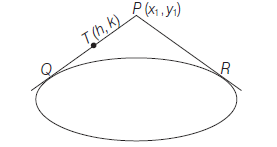
\(\therefore \quad\) Equation of \(P T\) is
\(
y-y_1=\frac{k-y_1}{h-x_1}\left(x-x_1\right)
\)
\(
\text { or } \quad y=\left(\frac{k-y_1}{h-x_1}\right) x+\left(\frac{h y_1-k x_1}{h-x_1}\right)
\)
which is the tangent to the ellipse
\(
\begin{array}{rlrl}
& \frac{x^2}{a^2}+\frac{y^2}{b^2} & =1 \\
& \therefore & c^2 & =a^2 m^2+b^2 \\
& \text { or } & \left(\frac{h y_1-k x_1}{h-x_1}\right)^2 & =a^2\left(\frac{k-y_1}{h-x_1}\right)^2+b^2 \\
\Rightarrow & & \left(h y_1-k x_1\right)^2 & =a^2\left(k-y_1\right)^2+b^2\left(h-x_1\right)^2
\end{array}
\)
Hence, locus of \((h, k)\) is
\(
\left(x y_1-x_1 y\right)^2=a^2\left(y-y_1\right)^2+b^2\left(x-x_1\right)^2
\)
\(
\text { or } \quad\left(x y_1-x_1 y\right)^2=\left(b^2 x^2+a^2 y^2\right)+\left(b^2 x_1^2+a^2 y_1^2\right)-2\left(b^2 x x_1+a^2 y y_1\right)
\)
\(
\text { or } \quad\left(\frac{x y_1-x_1 y}{a b}\right)^2=\left(\frac{x^2}{a^2}+\frac{y^2}{b^2}\right)+\left(\frac{x_1^2}{a^2}+\frac{y_1^2}{b^2}\right)-2\left(\frac{x x_1}{a^2}+\frac{y y_1}{b^2}\right)
\)
\(
\text { or } \quad\left(\frac{x y_1-x_1 y}{a b}\right)^2-\left(\frac{x^2}{a^2}+\frac{y^2}{b^2}\right)-\left(\frac{x_1^2}{a^2}+\frac{y_1^2}{b^2}\right)+\left(\frac{x x_1}{a^2}+\frac{y y_1}{b^2}\right)^2
\)
\(
\begin{aligned}
& \quad=\left(\frac{x x_1}{a^2}+\frac{y y_1}{b^2}\right)^2+1-2\left(\frac{x x_1}{a^2}+\frac{y y_1}{b^2}\right) \\
& \text { or } \quad\left(\frac{x^2}{a^2}+\frac{y^2}{b^2}-1\right)\left(\frac{x_1^2}{a^2}+\frac{y_1^2}{b^2}-1\right)=\left(\frac{x x_1}{a^2}+\frac{y y_1}{b^2}-1\right)^2 \\
& \text { or } \quad S S_1=T^2
\end{aligned}
\)
Remark
- \(S=0\) is the equation of the curve, \(S_1\) is obtained from \(S\) by replacing \(x\) by \(x_1\) and \(y\) by \(y_1\) and \(T=0\) is the equation of tangent at \(\left(x_1, y_1\right)\) to \(S=0\)
Chord of Contact
Theorem : The equation of chord of contact of tangents drawn from a point \(\left(x_1, y_1\right)\) to the ellipse \(\frac{x^2}{a^2}+\frac{y^2}{b^2}=1\) is \(\frac{x x_1}{a^2}+\frac{y y_1}{b^2}=1\)
Proof : Let \(P Q\) and \(P R\) be the tangents drawn from a point \(P\left(x_1, y_1\right)\) to the ellipse \(\frac{x^2}{a^2}+\frac{y^2}{b^2}=1\) such that
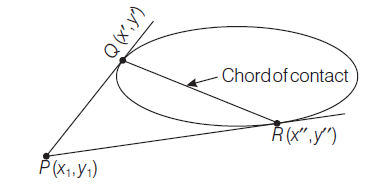
\(
Q \equiv\left(x^{\prime}, y^{\prime}\right) \quad \text { and } \quad R \equiv\left(x^{\prime \prime}, y^{\prime \prime}\right)
\)
are the points of contacts of these tangents the chord \(Q R\) is called chord of contact of the ellipse
\(
\frac{x^2}{a^2}+\frac{y^2}{b^2}=1
\)
Equations of tangents at \(Q\left(x^{\prime}, y^{\prime}\right)\) and \(R\left(x^{\prime \prime}, y^{\prime \prime}\right)\) are
\(
\frac{x x^{\prime}}{a^2}+\frac{y y^{\prime}}{b^2}=1
\)
and \(\frac{x x^{\prime \prime}}{a^2}+\frac{y y^{\prime \prime}}{b^2}=1\), respectively
These tangents pass through \(P\left(x_1, y_1\right)\) therefore,
\(
\begin{aligned}
& \quad \frac{x^{\prime} x_1}{a^2}+\frac{y^{\prime} y_1}{b^2}=1 \text { and } \frac{x^{\prime \prime} x_1}{a^2}+\frac{y^{\prime \prime} y_1}{b^2}=1 \\
& \Rightarrow \quad\left(x^{\prime}, y^{\prime}\right) \text { and }\left(x^{\prime \prime}, y^{\prime \prime}\right) \text { lie on } \frac{x x_1}{a^2}+\frac{y y_1}{b^2}=1
\end{aligned}
\)
Hence, the equation \(Q R\) is \(\frac{x x_1}{a^2}+\frac{y y_1}{b^2}=1\)
which is same as the equation of tangent but position of point differ.
Example 40: Find the locus of the points of the intersection of tangents to ellipse \(\frac{x^2}{a^2}+\frac{y^2}{b^2}=1\) which make an angle \(\theta\).
Answer: Given ellipse is \(\frac{x^2}{a^2}+\frac{y^2}{b^2}=1 \dots(i)\)
Equation of any tangent to ellipse Eq. (i) in terms of slope \((m)\) is \(y=m x+\sqrt{\left(a^2 m^2+b^2\right)}\)
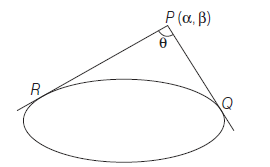
Since, its passes through \(P(\alpha, \beta)\) then
\(
\beta=m \alpha+\sqrt{\left(a^2 m^2+b^2\right)}
\)
\(
\begin{array}{ll}
\Rightarrow & (\beta-m \alpha)=\sqrt{\left(a^2 m^2+b^2\right)} \\
\Rightarrow & (\beta-m \alpha)^2=a^2 m^2+b^2 \\
\Rightarrow & m^2\left(a^2-\alpha^2\right)+2 \alpha \beta m+\left(b^2-\beta^2\right)=0 \dots(ii)
\end{array}
\)
Eq. (ii) being a quadratic equation in \(m\).
Let roots of Eq. (ii) are \(m_1\) and \(m_2\), then
\(
\begin{array}{ll}
\therefore & m_1+m_2=-\frac{2 \alpha \beta}{\left(a^2-\alpha^2\right)}, m_1 m_2=\frac{b^2-\beta^2}{a^2-\alpha^2} \\
\therefore & \left(m_1-m_2\right)=\sqrt{\left(m_1+m_2\right)^2-4 m_1 m_2}
\end{array}
\)
\(
\begin{aligned}
& =\sqrt{\frac{4 \alpha^2 \beta^2}{\left(a^2-\alpha^2\right)^2}-\frac{4\left(b^2-\beta^2\right)}{\left(a^2-\alpha^2\right)}} \\
& =\sqrt{\frac{4 \alpha^2 \beta^2-4\left(b^2-\beta^2\right)\left(a^2-\alpha^2\right)}{\left(a^2-\alpha^2\right)^2}} \\
& =\sqrt{\frac{4\left\{\alpha^2 \beta^2-a^2 b^2+b^2 \alpha^2+a^2 \beta^2-\alpha^2 \beta^2\right\}}{\left(a^2-\alpha^2\right)^2}} \\
& =\frac{2}{\left|\left(a^2-\alpha^2\right)\right|} \sqrt{\left(a^2 \beta^2+b^2 \alpha^2-a^2 b^2\right)}
\end{aligned}
\)
\(\because \theta\) be the angle between these two tangents, then
\(
\begin{aligned}
& \tan \theta=\left|\frac{m_1-m_2}{1+m_1 m_2}\right| \\
& =\left|\frac{\frac{2}{\left(a^2-\alpha^2\right)} \sqrt{\left(a^2 \beta^2+b^2 \alpha^2-a^2 b^2\right)}}{\left(1+\frac{b^2-\beta^2}{a^2-\alpha^2}\right)}\right| \\
& \tan \theta=\left|\frac{2 \sqrt{\left(a^2 \beta^2+b^2 \alpha^2-a^2 b^2\right)}}{a^2+b^2-\alpha^2-\beta^2}\right| \\
&
\end{aligned}
\)
\(
\begin{array}{lll}
\text { or } & \left(a^2+b^2-\alpha^2-\beta^2\right)^2 \tan ^2 \theta=4 & \left(a^2 \beta^2+b^2 \alpha^2-a^2 b^2\right) \\
\Rightarrow & \left(\alpha^2+\beta^2-a^2-b^2\right)^2 \tan ^2 \theta=4 & \left(b^2 \alpha^2+a^2 \beta^2-a^2 b^2\right)
\end{array}
\)
\(\therefore\) Locus of \(P(\alpha, \beta)\) is
\(
\left(x^2+y^2-a^2-b^2\right)^2 \tan ^2 \theta=4 \quad\left(b^2 x^2+a^2 y^2-a^2 b^2\right)
\)
Example 41: Prove that the chord of contact of tangents drawn from the point \((h, k)\) to the ellipse \(\frac{x^2}{a^2}+\frac{y^2}{b^2}=1\) will subtend \(a\) right angle at the centre, if \(\frac{h^2}{a^4}+\frac{k^2}{b^4}=\frac{1}{a^2}+\frac{1}{b^2}\). Also, find the locus of \((h, k)\).
Answer: The equation of chord of contact of tangents drawn from \(P(h, k)\) to the ellipse \(\frac{x^2}{a^2}+\frac{y^2}{b^2}=1\)
is \(\frac{h x}{a^2}+\frac{k y}{b^2}=1 \dots(i)\)
The equation of the straight lines \(C A\) and \(C B\) is obtained by making homogeneous ellipse \(\frac{x^2}{a^2}+\frac{y^2}{b^2}=1\) with the help of Eqn (i)
\(
\begin{array}{ll}
\therefore & \frac{x^2}{a^2}+\frac{y^2}{b^2}=\left(\frac{h x}{a^2}+\frac{k y}{b^2}\right)^2 \\
\Rightarrow & \left(\frac{k^2}{a^4}-\frac{1}{a^2}\right) x^2+\left(\frac{k^2}{b^4}-\frac{1}{b^2}\right) y^2+\frac{2 h k}{a^2 b^2} x y=0 \dots(ii)
\end{array}
\)
But given \(\angle A C B=90^{\circ}\)
\(\therefore\) Coefficient of \(x^2+\) Coefficient of \(y^2=0\)
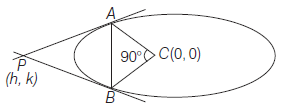
\(
\begin{array}{ll}
\Rightarrow & \frac{h^2}{a^4}-\frac{1}{a^2}+\frac{k^2}{b^4}-\frac{1}{b^2}=0 \\
\Rightarrow & \frac{h^2}{a^4}+\frac{k^2}{b^4}=\frac{1}{a^2}+\frac{1}{b^2}
\end{array}
\)
Hence, locus of \((h, k)\) is
\(
\frac{x^2}{a^4}+\frac{y^2}{b^4}=\frac{1}{a^2}+\frac{1}{b^2}
\)
Chord Bisected at a Given Point
Theorem : The equation of a chord of the ellipse
\(
\frac{x^2}{a^2}+\frac{y^2}{b^2}=1
\)
bisected at the point \(\left(x_1, y_1\right)\) is given by
\(
\begin{aligned}
\frac{x x_1}{a^2}+\frac{y y_1}{b^2}-1 & =\frac{x_1^2}{a^2}+\frac{y_1^2}{b^2}-1 \\
\text { or } T & =S_1
\end{aligned}
\)
Proof : Let \(Q \equiv\left(x_2, y_2\right)\) and \(R \equiv\left(x_3, y_3\right)\) be the end points of a chord \(Q R\) of the ellipse \(\frac{x^2}{a^2}+\frac{y^2}{b^2}=1\) and let \(P \equiv\left(x_1, y_1\right)\) be its mid point.
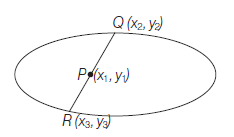
\(
\text { Now, } Q \equiv\left(x_2, y_2\right) \text { and } R \equiv\left(x_3, y_3\right) \text { lie on } \frac{x^2}{a^2}+\frac{y^2}{b^2}=1 \text {, then }
\)
\(
\frac{x_2^2}{a^2}+\frac{y_2^2}{b^2}=1 \dots(i)
\)
\(
\text {and } \frac{x_3^2}{a^2}+\frac{y_3^2}{b^2}=1 \dots(ii)
\)
Subtracting Eq. (ii) from Eq. (i),
\(
\begin{array}{lc}
\therefore \frac{1}{a^2}\left(x_2^2-x_3^2\right)+\frac{1}{b^2}\left(y_2^2-y_3^2\right)=0 \\
\Rightarrow \frac{\left(x_2+x_3\right)\left(x_2-x_3\right)}{a^2}+\frac{\left(y_2+y_3\right)\left(y_2-y_3\right)}{b^2}=0 \\
\Rightarrow \frac{y_2-y_3}{x_2-x_3}=-\frac{b^2\left(x_2+x_3\right)}{a^2\left(y_2+y_3\right)}=-\frac{b^2}{a^2} \cdot \frac{2 x_1}{2 y_1} \\
\left(\because x_1=\frac{x_2+x_3}{2} \text { and } y_1=\frac{y_2+y_3}{2}\right)
\end{array}
\)
\(
=-\frac{b^2 x_1}{a^2 y_1} \dots(iii)
\)
\(\therefore\) Equation of \(Q R\) is
\(
y-y_1=\frac{y_2-y_3}{x_2-x_3}\left(x-x_1\right)
\)
\(
\Rightarrow \quad y-y_1=-\frac{b^2 x_1}{a^2 y_1}\left(x-x_1\right) \text { [from Eq. (iii)] }
\)
\(
\begin{aligned}
& \Rightarrow \quad \frac{y y_1}{b^2}-\frac{y_1^2}{b^2}=-\frac{x x_1}{a^2}+\frac{x_1^2}{a^2} \\
& \Rightarrow \quad \frac{x x_1}{a^2}+\frac{y y_1}{b^2}-1=\frac{x_1^2}{a^2}+\frac{y_1^2}{b^2}-1 \text { or } T=S_1
\end{aligned}
\)
where, \(T=\frac{x x_1}{a^2}+\frac{y y_1}{b^2}-1\)
\(
\text { and } \quad S_1=\frac{x_1^2}{a^2}+\frac{y_1^2}{b^2}-1
\)
Example 42: Prove that the locus of the middle points of normal chords of the ellipse \(\frac{x^2}{a^2}+\frac{y^2}{b^2}=1\) is the curve \(\left(\frac{x^2}{a^2}+\frac{y^2}{b^2}\right)^2\left(\frac{a^6}{x^2}+\frac{b^6}{y^2}\right)=\left(a^2-b^2\right)^2\).
Answer: Let \((h, k)\) be the middle point of any chord of an ellipse, then its equation is \(T=S_1\)

\(
\frac{x h}{a^2}+\frac{y k}{b^2}-1=\frac{h^2}{a^2}+\frac{k^2}{b^2}-1
\)
\(
\frac{x h}{a^2}+\frac{y k}{b^2}=\frac{h^2}{a^2}+\frac{k^2}{b^2} \dots(i)
\)
If Eq. (i) is a normal chords, then it must be of the form
\(
a x \sec \phi-b y \operatorname{cosec} \phi=a^2-b^2 \dots(ii)
\)
Thus, the Eqs. (i) and (ii) represents the same normal chord of the ellipse with its middle point \((h, k)\).
Hence, they are identical and comparing their co-efficients,
\(
\text { we get } \frac{h / a^2}{a \sec \phi}=\frac{k / b^2}{-b \operatorname{cosec} \phi}=\frac{\frac{h^2}{a^2}+\frac{k^2}{b^2}}{\left(a^2-b^2\right)}
\)
\(
\Rightarrow \quad \cos \phi=\frac{a^3}{h} \frac{\left(\frac{h^2}{a^2}+\frac{k^2}{b^2}\right)}{\left(a^2-b^2\right)} \dots(iii)
\)
\(
\text { and } \quad \sin \phi=-\frac{b^3}{k} \frac{\left(\frac{h^2}{a^2}+\frac{k^2}{b^2}\right)}{\left(a^2-b^2\right)} \dots(iv)
\)
Squaring and adding Eqs. (iii) and (iv), then
\(
\cos ^2 \phi+\sin ^2 \phi=\frac{\left(\frac{a^6}{h^2}+\frac{b^6}{k^2}\right)\left(\frac{h^2}{a^2}+\frac{k^2}{b^2}\right)^2}{\left(a^2-b^2\right)^2}
\)
\(
\begin{array}{lc}
\Rightarrow & 1=\frac{\left(\frac{a^6}{h^2}+\frac{b^6}{k^2}\right)\left(\frac{h^2}{a^2}+\frac{k^2}{b^2}\right)^2}{\left(a^2-b^2\right)^2} \\
\Rightarrow & \left(\frac{h^2}{a^2}+\frac{k^2}{b^2}\right)^2\left(\frac{a^6}{h^2}+\frac{b^6}{k^2}\right)=\left(a^2-b^2\right)^2
\end{array}
\)
Hence, locus of \((h, k)\) is \(\left(\frac{x^2}{a^2}+\frac{y^2}{b^2}\right)^2\left(\frac{a^6}{x^2}+\frac{b^6}{y^2}\right)=\left(a^2-b^2\right)^2\)
Example 43: Show that the locus of the middle points of chords of an ellipse which pass through a fixed point, is another ellipse
Answer: Let \(P\left(x_1, y_1\right)\) be the middle point of any chord \(A B\) of the ellipse \(\frac{x^2}{a^2}+\frac{y^2}{b^2}=1\), then equation of chord \(A B\) is
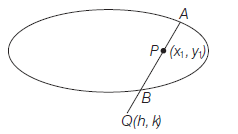
\(
\begin{aligned}
T & =S_1 \\
\frac{x x_1}{a^2}+\frac{y y_1}{b^2}-1 & =\frac{x_1^2}{a^2}+\frac{y_1^2}{b^2}-1 \\
\frac{x x_1}{a^2}+\frac{y y_1}{b^2} & =\frac{x_1^2}{a^2}+\frac{y_1^2}{b^2} \dots(i)
\end{aligned}
\)
But it passes through a fixed point \(Q(h, k)\) its coordinates must satisfy Eq. (i),
\(
\therefore \quad \frac{h x_1}{a^2}+\frac{k y_1}{b^2}=\frac{x_1^2}{a^2}+\frac{y_1^2}{b^2}
\)
This can be re-written as
\(
\frac{\left(x_1-\frac{h}{2}\right)^2}{a^2}+\frac{\left(y_1-\frac{k}{2}\right)^2}{b^2}=\frac{1}{4}\left(\frac{h^2}{a^2}+\frac{k^2}{b^2}\right)
\)
Hence, locus of \(P\left(x_1, y_1\right)\) is
\(
\frac{\left(x-\frac{h}{2}\right)^2}{a^2}+\frac{\left(y-\frac{k}{2}\right)^2}{b^2}=\frac{1}{4}\left(\frac{h^2}{a^2}+\frac{k^2}{b^2}\right)
\)
Its obviously an ellipse with centre at \(\left(\frac{h}{2}, \frac{k}{2}\right)\) and axes parallel to coordinates axes.
Diameter
The locus of the middle points of a system of parallel chords of an ellipse is called a diameter and the point where the diameter intersects the ellipse is called the vertex of the diameter.
Let \(y=m x+c\) be system of parallel chords to \(\frac{x^2}{a^2}+\frac{y^2}{b^2}=1\) for different chords \(c\) varies, \(m\) remains constant.
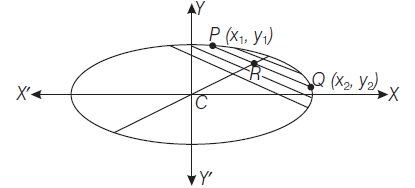
Let the extremities of any chord \(P Q\) of the set be \(P\left(x_1, y_1\right)\) and \(Q\left(x_2, y_2\right)\) and let its middle point be \(R(h, k)\), then solving equations.
\(
\begin{array}{lc}
& \frac{x^2}{a^2}+\frac{y^2}{b^2}=1 \text { and } y=m x+c \\
\therefore & \frac{x^2}{a^2}+\frac{(m x+c)^2}{b^2}=1 \\
\Rightarrow & \left(a^2 m^2+b^2\right) x^2+2 m c a^2 x+a^2\left(c^2-b^2\right)=0
\end{array}
\)
Since, \(x_1\) and \(x_2\) be the roots of this equation, then
\(
x_1+x_2=-\frac{2 m c a^2}{a^2 m^2+b^2} \dots(i)
\)
Since, \((h, k)\) be the middle point of \(Q R\), then
\(
h=\frac{x_1+x_2}{2}
\)
then, from Eq. (i),
\(
\begin{aligned}
2 h & =-\frac{2 m c a^2}{a^2 m^2+b^2} \\
\Rightarrow \quad h & =-\frac{m c a^2}{a^2 m^2+b^2} \dots(ii)
\end{aligned}
\)
\(
\begin{aligned}
\operatorname{but}(h, k) \text { lies on } y & =m x+c \\
\therefore \quad k & =m h+c, c=k-m h \dots(iii)
\end{aligned}
\)
From Eqs. (ii) and (iii), then, \(h=-\frac{m a^2(k-m h)}{a^2 m^2+b^2}\)
\(
\begin{aligned}
\Rightarrow & a^2 m^2 h+b^2 h =-m k a^2+m^2 a^2 h \\
\Rightarrow & b^2 h =-m k a^2 \text { or } k=-\frac{b^2 h}{a^2 m}
\end{aligned}
\)
Hence, locus of \(R(h, k)\) is \(y=-\frac{b^2 x}{a^2 m}\)
which is diameter of the ellipse passing through \((0,0)\).
Alternate: Let \((h, k)\) be the middle point of the chord \(y=m x+c\) of the ellipse \(\frac{x^2}{a^2}+\frac{y^2}{b^2}=1\), then
\(
\begin{gathered}
T=S_1 \\
\frac{x h}{a^2}+\frac{k y}{b^2}=\frac{h^2}{a^2}+\frac{k^2}{b^2}
\end{gathered}
\)
\(
\begin{array}{ll}
\therefore & \text { Slope }=-\frac{b^2 h}{a^2 k}=m \\
\Rightarrow & k=-\frac{b^2 h}{a^2 m}
\end{array}
\)
Hence, locus of the mid-point is
\(
y=-\frac{b^2 x}{a^2 m}
\)
Conjugate Diameters
Two diameters are said to be conjugate when each bisects all chords parallel to the other. If \(y=m x\) and \(y=m_1 x\) be two conjugate diameters of an ellipse, then \(m m_1=\frac{b^2}{a^2}\).
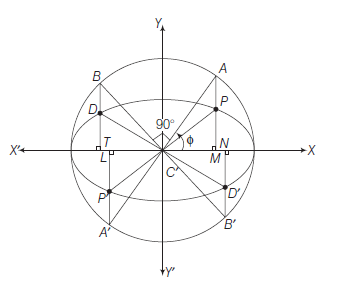
Conjugate diameters of circle i.e. \(A A^{\prime}\) and \(B B^{\prime}\) are perpendicular to each other. Hence, conjugate diameters of ellipse are \(P P^{\prime}\) and \(D D^{\prime}\).
Hence, angle between conjugate diameters of ellipse \(\neq 90^{\circ}\).
Now the co-ordinates of the four extremities of two conjugate diameters are
\(
\begin{aligned}
& P(a \cos \phi, b \sin \phi), P^{\prime}(-a \cos \phi,-b \sin \phi), \\
& D(-a \sin \phi, b \cos \phi), D^{\prime}(a \sin \phi,-b \cos \phi)
\end{aligned}
\)
Properties of Conjugate Diameters
Property 1 : The eccentric angles of the ends of a pair of conjugate diameters of an ellipse differ by a right angle. Let \(P C P^{\prime}\) and \(D C D^{\prime}\) be two conjugate diameters of the ellipse \(\frac{x^2}{a^2}+\frac{y^2}{b^2}=1\) and let the eccentric angles of the

extremities \(P\) and \(D\) be \(\phi\) and \(\phi^{\prime}\) respectively. Then, the co-ordinates of \(P\) and \(D\) are \((a \cos \phi, b \sin \phi)\) and \(\left(a \cos \phi^{\prime}, b \sin \phi^{\prime}\right)\) respectively.
Now \(m_1=\) slope of \(C P=\frac{b}{a} \tan \phi\)
and \(m_2=\) slope of \(C D=\frac{b}{a} \tan \phi^{\prime}\)
since, the diameters \(P C P^{\prime}\) and \(D C D^{\prime}\) are conjugate diameters.
\(\therefore \quad m_1 m_2=-\frac{b^2}{a^2}\)
\(
\begin{array}{ll}
\Rightarrow & \frac{b^2}{a^2} \tan \phi \tan \phi^{\prime}=-\frac{b^2}{a^2} \\
\Rightarrow & \tan \phi \tan \phi^{\prime}=-1 \\
\Rightarrow & \tan \phi=-\cot \phi^{\prime}=\tan \left(\frac{\pi}{2}+\phi^{\prime}\right) \\
\Rightarrow & \phi=\frac{\pi}{2}+\phi^{\prime} \Rightarrow \phi-\phi^{\prime}=\frac{\pi}{2}
\end{array}
\)
Property 2: The sum of the squares of any two conjugate semi diameters of an ellipse is constant and equal to the sum of the squares of the semi-axes of the ellipse i.e.
\(
C P^2+C D^2=a^2+b^2
\)
Let \(C P\) and \(C D\) be two conjugate semi-diameters of an ellipse \(\frac{x^2}{a^2}+\frac{y^2}{b^2}=1\) and let eccentric angle of \(P\) is \(\phi\). The eccentric angle of \(D\) is \(\frac{\pi}{2}+\phi\). So the coordinates of \(P\) and \(D\) are
\(
(a \cos \phi, b \sin \phi) \text { and }\left(a \cos \left(\frac{\pi}{2}+\phi\right), b \sin \left(\frac{\pi}{2}+\phi\right)\right)
\)
\(
\text { i.e. }(-a \sin \phi, b \cos \phi) \text { respectively }
\)
\(
\therefore \quad C P^2+C D^2=\left(a^2 \cos ^2 \phi+b^2 \sin ^2 \phi\right)+\left(a^2 \sin ^2 \phi+b^2 \cos ^2 \phi\right)
\)
\(
=a^2+b^2
\)
Property 3 : The product of the focal distances of a point on an ellipse is equal to the square of the semi diameter which is conjugate to the diameter through the point.
Let \(P C P^{\prime}\) and \(D C D^{\prime}\) be the conjugate diameters of an ellipse and let the eccentric angle of \(P\) is \(\phi\) then coordinates of \(P\) is \((a \cos \phi, b \sin \phi)\)
\(\therefore\) Coordinates of \(D\) is \((-a \sin \phi, b \cos \phi)\)
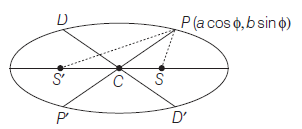
Let \(S\) and \(S^{\prime}\) be two foci of the ellipse. Then
\(
\begin{aligned}
S P \cdot S^{\prime} P & =(a-a e \cos \phi) \cdot(a+a e \cos \phi) \\
& =a^2-a^2 e^2 \cos ^2 \phi \\
& =a^2-\left(a^2-b^2\right) \cos ^2 \phi \quad\left\{\because b^2=a^2\left(1-e^2\right)\right\} \\
& =a^2 \sin ^2 \phi+b^2 \cos ^2 \phi=C D^2 \left\{\therefore a^2-b^2=a^2 e^2\right\}
\end{aligned}
\)
Property 4: The tangents at the extremities of a pair of conjugate diameters form a parallelogram whose area is constant and equal to product of the axes.
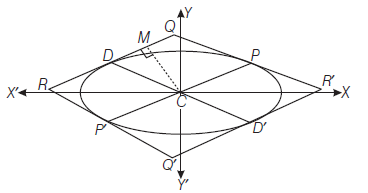
Let \(P C P^{\prime}\) and \(D C D^{\prime}\) be a pair of conjugate diameters of the ellipse \(\frac{x^2}{a^2}+\frac{y^2}{b^2}=1\). Let the eccentric angle of \(P\) be \(\phi\). Then the eccentric angle of \(D\) is \(\left(\frac{\pi}{2}+\phi\right)\) so the coordinates of \(P\) and \(D\) are
\(
(a \cos \phi, b \sin \phi) \text { and }\left(a \cos \left(\frac{\pi}{2}+\phi\right), b \sin \left(\frac{\pi}{2}+\phi\right)\right)
\)
i.e. \((-a \sin \phi, b \cos \phi)\)
Similarly the coordinates of \(P^{\prime}\) and \(D^{\prime}\) are \((-a \cos \phi,-b \sin \phi)\) and \((a \sin \phi,-b \cos \phi)\) respectively. Equation of tangents at \(P, D, P^{\prime}\) and \(D^{\prime}\) are respectively.
\(
\frac{x}{a} \cos \phi+\frac{y}{b} \sin \phi=1,-\frac{x}{a} \sin \phi+\frac{y}{b} \cos \phi=1,-\frac{x}{a} \cos \phi-\frac{y}{b} \sin \phi=1
\)
and \(\quad \frac{x}{a} \sin \phi-\frac{y}{b} \cos \phi=1\)
Clearly the tangents at \(P\) and \(P^{\prime}\) are parallel. Also, the tangents at \(D\) and \(D^{\prime}\) are parallel. Hence, the tangents at \(P, D, P^{\prime}, D^{\prime}\) form a parallelogram.
Area of parallelogram \(Q R Q^{\prime} R^{\prime}=4\)
(the area of parallelogram \(Q D C P\) )
\(
\begin{aligned}
& =4 \cdot|Q D| \cdot\{\perp \text { from } C \text { on } Q D\} \\
& =4 \cdot|C P| \cdot\{\perp \text { from } C \text { on } Q D\} \dots(i)
\end{aligned}
\)
Now \(\quad|C P|=\sqrt{\left(a^2 \cos ^2 \phi+b^2 \sin ^2 \phi\right)}\)
\(\because \quad\) tangent at \(D\) is \(\quad-\frac{x}{a} \sin \phi+\frac{y}{b} \cos \phi=1\)
\(\therefore \quad \perp\) from \(C\) on
\(
Q D=\frac{1}{\sqrt{\frac{\sin ^2 \phi}{a^2}+\frac{\cos ^2 \phi}{b^2}}}=\frac{a b}{\sqrt{a^2 \cos ^2 \phi+b^2 \sin ^2 \phi}}
\)
Now from Eq. (i),
Area of parallelogram \(Q R Q^{\prime} R^{\prime}\)
\(
\begin{aligned}
& =4 \times \sqrt{\left(a^2 \cos ^2 \phi+b^2 \sin ^2 \phi\right)} \times \frac{a b}{\sqrt{\left.a^2 \cos ^2 \phi+b^2 \sin ^2 \phi\right)}} \\
& =4 a b(=\text { constant })=(2 a)(2 b) \\
& =\text { Area of rectangle contained under major and minor axes. } \\
\end{aligned}
\)
Property 5 : The polar of any point with respect to ellipse is parallel to the diameter to the one on which the point lies. Hence obtain the equation of the chord whose mid-point is \((h, k)\).
Let \((h, k)\) be the point on the diameter \(y=m_1 x\)
\(
\therefore \quad m_1=k / h
\)
any diameter conjugate to it is \(y=m_2 x\)
but \(m_1 m_2=-\frac{b^2}{a^2} \Rightarrow \frac{k}{h} m_2=-\frac{b^2}{a^2}\)
\(
\therefore \quad m_2=-\frac{b^2 h}{a^2 k}
\)
Polar of \((h, k)\) is \(\frac{h x}{a^2}+\frac{k y}{b^2}=1 \dots(i)\)
Its slope is \(-\frac{b^2 h}{a^2 k}=m_2\) and hence parallel.
Now, equation of chord parallel to the Eq. (i) is
\(
\frac{h x}{a^2}+\frac{k y}{b^2}=\lambda \dots(ii)
\)
It is passes through points \((h, k)\)
\(
\therefore \quad \lambda=\frac{h^2}{a^2}+\frac{k^2}{b^2} \dots(iii)
\)
From Eqs. (ii) and (iii), \(\frac{h x}{a^2}+\frac{k y}{b^2}=\frac{h^2}{a^2}+\frac{k^2}{b^2}\) i.e.
\(
T=S_1
\)
which is the equation of chord of the ellipse, if mid-points is \((h, k)\).
Equi-Conjugate Diameters
Two conjugate diameters are called equi-conjugate if their lengths are equal. In such cases therefore.
\(
\begin{array}{cc}
& (C P)^2=(C D)^2 \\
\therefore & a^2 \cos ^2 \phi+b^2 \sin ^2 \phi=a^2 \sin ^2 \phi+b^2 \cos ^2 \phi \\
\Rightarrow \quad & a^2 \left(\cos ^2 \phi-\sin ^2 \phi\right)-b^2\left(\cos ^2 \phi-\sin ^2 \phi\right)=0
\end{array}
\)
\(
\begin{array}{lc}
\Rightarrow & \left(a^2-b^2\right) \cos 2 \phi=0 \\
\because & \left(a^2-b^2\right) \neq 0 \\
\therefore & \cos 2 \phi=0 \\
\therefore & \phi=\frac{\pi}{4} \text { or } \frac{3 \pi}{4} \\
\therefore & (C P)=(C D)=\sqrt{\frac{\left(a^2+b^2\right)}{2}}
\end{array}
\)
Example 44: Show that the tangents at the ends of conjugate diameters of the ellipse \(x^2 / a^2+y^2 / b^2=1\) intersect on the ellipse \(x^2 / a^2+y^2 / b^2=2\).
Or Prove that the locus of the poles of the line joining the extremities of two conjugate diameters is the ellipse \(x^2 / a^2+y^2 / b^2=2\).
Answer: Let \(C P\) and \(C D\) be two semi-conjugate diameters, so that if eccentric angle of \(P\) is \(\phi\) then eccentric angle of \(D\) is \(\frac{\pi}{2}+\phi\)

\(\therefore\) Coordinates of \(P\) and \(D\) are
\((a \cos \phi, b \sin \phi)\) and \(\left(a \cos \left(\frac{\pi}{2}+\phi\right), b \sin \left(\frac{\pi}{2}+\phi\right)\right)\)
respectively
\(\therefore\) Equation of \((P D)\) is
\(
\frac{x}{a} \cos \left(\frac{\phi+\frac{\pi}{2}+\phi}{2}\right)+\frac{y}{b} \sin \left(\frac{\phi+\frac{\pi}{2}+\phi}{2}\right)=\cos \left(\frac{\frac{\pi}{2}+\phi-\phi}{2}\right)
\)
\(
\Rightarrow \quad \frac{x}{a} \cos \left(\frac{\pi}{4}+\phi\right)+\frac{y}{b} \sin \left(\frac{\pi}{4}+\phi\right)=\frac{1}{\sqrt{2}} \dots(i)
\)
If its pole or point of intersection of tangents at its extremities be \((h, k)\), then its equation is the same as that of the polar or the chord of contact of \((h, k)\).
i.e. \(\frac{h x}{a^2}+\frac{k y}{b^2}=1\)
Since, Eqs. (i) and (ii) are identical, comparing
\(
\frac{h}{a \cos \left(\frac{\pi}{4}+\phi\right)}=\frac{k}{b \sin \left(\frac{\pi}{4}+\phi\right)}=\sqrt{2}
\)
\(
\text { or } \quad \sqrt{2} \cos \left(\frac{\pi}{4}+\phi\right)=\frac{h}{a} \dots(iii)
\)
\(
\text { or } \quad \sqrt{2} \sin \left(\frac{\pi}{4}+\phi\right)=\frac{k}{b} \dots(iv)
\)
Squaring and adding Eqs. (iii) and (iv), then
\(
\frac{h^2}{a^2}+\frac{k^2}{b^2}=2\left(\cos ^2\left(\frac{\pi}{4}+\phi\right)+\sin ^2\left(\frac{\pi}{4}+\phi\right)\right)
\)
\(
\therefore \quad \frac{h^2}{a^2}+\frac{k^2}{b^2}=2
\)
Hence, locus of \((h, k)\) is \(\frac{x^2}{a^2}+\frac{y^2}{b^2}=2\)
Alternate: Equation of tangents at \(P\) and \(D\) are
\(
\frac{x}{a} \cos \phi+\frac{y}{b} \sin \phi=1 \dots(i)
\)
\(
\text { and } \quad \frac{x}{a} \cos \left(\frac{\pi}{2}+\phi\right)+\frac{y}{b} \sin \left(\frac{\pi}{2}+\phi\right)=1
\)
\(
\text { i.e. } \quad-\frac{x}{a} \sin \phi+\frac{y}{b} \cos \phi=1 \dots(ii)
\)
Squaring and adding Eqs. (i) and (ii), we get
\(
\frac{x^2}{a^2}+\frac{y^2}{b^2}=2
\)
which is required locus.
Example 45: If \(x \cos \alpha+y \sin \alpha=p\) is a chord joining the ends \(P\) and \(D\) of conjugate semi-diameters, of the ellipse then prove that \(a^2 \cos ^2 \alpha+b^2 \sin ^2 \alpha=2 p^2\) and hence or otherwise deduce that the line PD always touches a similar ellipse.
Answer: Let equation of ellipse be \(\frac{x^2}{a^2}+\frac{y^2}{b^2}=1\), eccentric angle of \(P\) is \(\phi\), then eccentric angle of \(D\) is \(\frac{\pi}{2}+\phi\)
\(\therefore \quad\) Coordinates of \(P\) and \(D\) are \((a \cos \phi, b \sin \phi)\) and \(\left(a \cos \left(\frac{\pi}{2}+\phi\right), b \sin \left(\frac{\pi}{2}+\phi\right)\right)\)
\(\therefore\) Equation of \(P D\) is
\(
\frac{x}{a} \cos \left(\frac{\phi+\frac{\pi}{2}+\phi}{2}\right)+\frac{y}{b} \sin \left(\frac{\phi+\frac{\pi}{2}+\phi}{2}\right)=\cos \left(\frac{\frac{\pi}{2}+\phi-\phi}{2}\right)
\)
\(
\Rightarrow \quad \frac{x}{a} \cos \left(\frac{\pi}{4}+\phi\right)+\frac{y}{b} \sin \left(\frac{\pi}{4}+\phi\right)=\frac{1}{\sqrt{2}} \dots(i)
\)
If it is same as \(x \cos \alpha+y \sin \alpha=p \dots(ii)\)
then on comparing, we get
\(
\frac{\cos \left(\frac{\pi}{4}+\phi\right)}{a \cos \alpha}=\frac{\sin \left(\frac{\pi}{4}+\phi\right)}{b \sin \alpha}=\frac{1}{p \sqrt{2}}
\)
\(
\text { or } \quad a \cos \alpha=p \sqrt{2} \cos \left(\frac{\pi}{4}+\phi\right) \dots(iii)
\)
\(
\text { and } \quad b \sin \alpha=p \sqrt{2} \sin \left(\frac{\pi}{4}+\phi\right) \dots(iv)
\)
Squaring and adding Eq. (iii) and (iv), we get
\(
\begin{aligned}
& a^2 \cos ^2 \alpha+b^2 \sin ^2 \alpha=(p \sqrt{2})^2 \left\{\cos ^2\left(\frac{\pi}{4}+\phi\right)+\sin ^2\left(\frac{\pi}{4}+\phi\right)\right\}
\end{aligned}
\)
\(
\Rightarrow \quad a^2 \cos ^2 \alpha+b^2 \sin ^2 \alpha=2 p^2
\)
Again, line Eq. (i) can be written as
\(
\frac{x}{a / \sqrt{2}} \cos \theta+\frac{y}{b / \sqrt{2}} \sin \theta=1,
\)
where \(\theta=\frac{\pi}{4}+\phi\)
which is clearly a tangent to the ellipse
\(
\frac{x^2}{(a / \sqrt{2})^2}+\frac{y^2}{(b \sqrt{2})^2}=1 \text { or } \frac{x^2}{a^2}+\frac{y^2}{b^2}=\frac{1}{2} \dots(v)
\)
If \(e^{\prime}\) be its eccentricity, then
\(
\begin{aligned}
(b / \sqrt{2})^2 & =(a / \sqrt{2})^2\left(1-e^{\prime 2}\right) \\
\Rightarrow \quad b^2 & =a^2\left(1-e^{\prime 2}\right)
\end{aligned}
\)
\(
\begin{array}{rlrl}
& \text { but } & b^2 & =a^2\left(1-e^2\right) \\
\therefore & e =e^{\prime}
\end{array}
\)
Hence, ellipse (v) is a similar ellipse.
Director Circle
The locus of the point of intersection of the tangents to an ellipse \(\frac{x^2}{a^2}+\frac{y^2}{b^2}=1\) which are perpendicular to each other is called director circle.
Let any tangent in terms of slope of ellipse \(\frac{x^2}{a^2}+\frac{y^2}{b^2}=1\) is
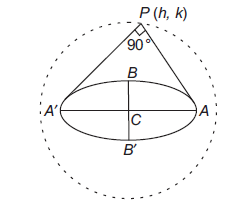
\(
y=m x+\sqrt{\left(a^2 m^2+b^2\right)}
\)
It is passes through \((h, k)\)
\(
\begin{aligned}
& \therefore \quad k=m h+\sqrt{\left(a^2 m^2+b^2\right)} \\
& (k-m h)^2=a^2 m^2+b^2 \\
&
\end{aligned}
\)
\(
\begin{array}{ll}
\Rightarrow & k^2+m^2 h^2-2 m h k=a^2 m^2+b^2 \\
\Rightarrow & m^2\left(h^2-a^2\right)-2 h k m+k^2-b^2=0
\end{array}
\)
It is quadratic equation in \(m\) let slope of two tangents are \(m_1\) and \(m_2\)
\(
\therefore \quad m_1 m_2=\frac{k^2-b^2}{h^2-a^2}
\)
\(
-1=\frac{k^2-b^2}{h^2-a^2} \text { ( } \because \text { tangents are perpendicular) }
\)
\(
\begin{aligned}
& \Rightarrow \quad-h^2+a^2=k^2-b^2 \\
& \text { or } \quad h^2+k^2=a^2+b^2 \\
&
\end{aligned}
\)
Hence, locus of \(P(h, k)\) is
\(
x^2+y^2=a^2+b^2
\)
Example 46: Tangents at right angles are drawn to the ellipse \(\frac{x^2}{a^2}+\frac{y^2}{b^2}=1\). Show that the locus of the middle points of the chord of contact is the curve
\(
\left(\frac{x^2}{a^2}+\frac{y^2}{b^2}\right)^2=\frac{x^2+y^2}{a^2+b^2}
\)
Answer: Let \(Q(h, k)\) be the middle point of the chord of contact
\(\therefore\) Equation of chord \(A B\) whose mid point \(Q(h, k)\) is
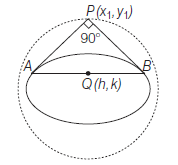
\(
T=S_1
\)
\(
\frac{h x}{a^2}+\frac{k y}{b^2}=\frac{h^2}{a^2}+\frac{k^2}{b^2} \dots(i)
\)
and equation of chord of contact \(A B\) with respect to \(P\left(x_1, y_1\right)\) is
\(
\frac{x x_1}{a^2}+\frac{y y_1}{b^2}=1 \dots(ii)
\)
the Eqs. (i) and (ii) are identical, hence comparing their coefficient, we get
\(
\frac{x_1}{h}=\frac{y_1}{k}=\frac{1}{\left(\frac{h^2}{a^2}+\frac{k^2}{b^2}\right)}
\)
\(
\begin{array}{ll}
\therefore & x_1=\frac{h}{\left(\frac{h^2}{a^2}+\frac{k^2}{b^2}\right)} \dots(iii) \\
\text { and } & y_1=\frac{k}{\left(\frac{h^2}{a^2}+\frac{k^2}{b^2}\right)} \dots(iv)
\end{array}
\)
Since tangents are at right angles, then the point \(\left(x_1, y_1\right)\) must lie on the director circle \(x^2+y^2=a^2+b^2\) of the ellipse
\(
x_1^2+y_1^2=a^2+b^2
\)
\(
\frac{h^2}{\left(\frac{h^2}{a^2}+\frac{k^2}{b^2}\right)^2}+\frac{k^2}{\left(\frac{h^2}{a^2}+\frac{k^2}{b^2}\right)^2}=a^2+b^2 \text { [from Eqs. (iii) and (iv)] }
\)
\(
\therefore \quad\left(\frac{h^2}{a^2}+\frac{k^2}{b^2}\right)^2=\frac{h^2+k^2}{a^2+b^2}
\)
Hence, locus of mid-point \(Q(h, k)\) is \(\left(\frac{x^2}{a^2}+\frac{y^2}{b^2}\right)^2=\frac{x^2+y^2}{a^2+b^2}\)
Sub-Tangent and Sub-Normal
Let the tangent and normal at \(P\left(x_1, y_1\right)\) meet the axes at \(T\) and \(G\) respectively.
Equation of tangent at \(P\left(x_1, y_1\right)\) to the ellipse \(\frac{x^2}{a^2}+\frac{y^2}{b^2}=1\) is
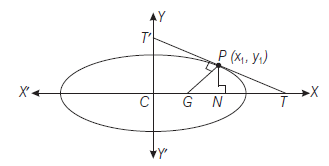
\(
\frac{x x_1}{a^2}+\frac{y y_1}{b^2}=1
\)
\(\because \quad T\) lies on \(X\)-axis.
Put \(y=0 \text { in Eq. (i) } \Rightarrow x=C T\)
\(
\therefore \quad C T=\frac{a^2}{x_1} \text { and } C N=x_1
\)
and length of sub-tangent \(N T=C T-C N=\frac{a^2}{x_1}-x_1\)
Equation of normal at \(P\left(x_1, y_1\right)\) to the ellipse
\(
\begin{aligned}
& \frac{x^2}{a^2}+\frac{y^2}{b^2}=1 \text { is } \\
& \frac{x-x_1}{x_1 / a^2}=\frac{y-y_1}{y_1 / b^2} \dots(ii)
\end{aligned}
\)
\(\because G\) lies on \(X\)-axis. Put \(y=0\) in Eq. (ii)
\(
\begin{array}{ll}
\Rightarrow & x=C G \\
\therefore & C G=x_1-\frac{b^2}{a^2} x_1
\end{array}
\)
\(\therefore\) Length of sub-normal
\(
\begin{aligned}
G N & =C N-C G=x_1-\left(x_1-\frac{b^2}{a^2} x_1\right) \\
& =\frac{b^2}{a^2} x_1=\left(1-e^2\right) x_1
\end{aligned}
\)
Concyclic Points
Any circle intersects an ellipse in two or four real points. They are called concyclic points and the sum of their eccentric angles is an even multiple of \(\pi\). If \(\alpha, \beta, \gamma, \delta\) be the eccentric angles of the four concyclic points on an ellipse, then prove that \(\alpha+\beta+\gamma+\delta=2 n \pi\) where \(n\) is any integer.
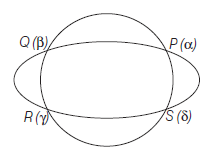
Let \(P, Q, R, S\) be four concyclic points on an ellipse, whose eccentric angles \(\alpha, \beta, \gamma, \delta\) respectively.
Then equation of the chords \(P Q\) and \(R S\) are (Take any two chords)
\(
\begin{aligned}
\frac{x}{a} \cos \left(\frac{\alpha+\beta}{2}\right)+\frac{y}{b} \sin \left(\frac{\alpha+\beta}{2}\right)-\cos \left(\frac{\alpha-\beta}{2}\right) & =0 \\
\text { and } \quad \frac{x}{a} \cos \left(\frac{\gamma+\delta}{2}\right)+\frac{y}{b} \sin \left(\frac{\gamma+\delta}{2}\right)-\cos \left(\frac{\gamma-\delta}{2}\right) & =0
\end{aligned}
\)
Now, the equation of any curve passing through \(P, Q, R\) and \(S\) is given by
\(
\begin{aligned}
& \left(\frac{x^2}{a^2}+\frac{y^2}{b^2}-1\right)+\lambda \\
& \left(\frac{x}{a} \cos \left(\frac{\alpha+\beta}{2}\right)+\frac{y}{b} \sin \left(\frac{\alpha+\beta}{2}\right)-\cos \left(\frac{\alpha-\beta}{2}\right)\right) \\
& \quad \times\left(\frac{x}{a} \cos \left(\frac{\gamma+\delta}{2}\right)+\frac{y}{b} \sin \left(\frac{\gamma+\delta}{2}\right)-\cos \left(\frac{\gamma-\delta}{2}\right)\right)=0
\end{aligned}
\)
But the given points are concyclic. Hence this equation will represent a circle, if co-efficient of \(x^2=\) co-efficient \(y^2\). and co-efficient of \(x y=0\)
Now equation of the co-efficient of \(x y=0\)
\(
\cos \left(\frac{\alpha+\beta}{2}\right) \sin \left(\frac{\gamma+\delta}{2}\right)+\sin \left(\frac{\alpha+\beta}{2}\right) \cos \left(\frac{\gamma+\delta}{2}\right)=0
\)
or \(\quad \sin \left(\frac{\alpha+\beta+\gamma+\delta}{2}\right)=0=\sin n \pi\)
\(\therefore \quad \frac{1}{2}(\alpha+\beta+\gamma+\delta)=n \pi \quad\) or \(\quad \alpha+\beta+\gamma+\delta=2 n \pi\)
where, \(n\) is any integer.
Hence, the sum of eccentric angles of four concylic points on an ellipse is always an even multiple of \(\pi\)
Corollary 1 : Prove that the common chords of a circle and an ellipse are equally inclined to the axes of the ellipse.
If the point of intersection of chords \(P Q\) and \(R S\) is \(T\), then equation of chord \(P Q\) is
\(
\frac{x}{a} \cos \left(\frac{\alpha+\beta}{2}\right)+\frac{y}{b} \sin \left(\frac{\alpha+\beta}{2}\right)=\cos \left(\frac{\alpha-\beta}{2}\right)
\)
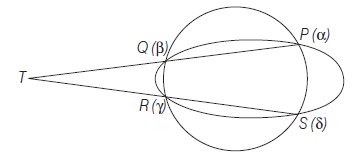
\(
\begin{aligned}
\therefore \text { Slope of } P Q & =-\frac{b}{a} \cot \left(\frac{\alpha+\beta}{2}\right) \\
& =-\frac{b}{a} \cot \left(n \pi-\frac{\gamma+\delta}{2}\right)(\because \alpha+\beta+\gamma+\delta=2 n \pi) \\
& =\frac{b}{a} \cot \left(\frac{\gamma+\delta}{2}\right)=-(\text { slope of } R S)
\end{aligned}
\)
Hence, \(P Q\) and \(R S\) are equally inclined to the axis of \(x\).
Corollary 2: Find the centre of the circle passing through the three points on an ellipse whose eccentric angles are \(\alpha, \beta, \gamma\).
Let the point of intersection of ellipse
\(
\frac{x^2}{a^2}+\frac{y^2}{b^2}=1 \dots(i)
\)
and circle \(x^2+y^2+2 g x+2 f y+c=0 \dots(ii)\)
be \(\alpha, \beta, \gamma, \delta\)
\(
\therefore \quad \alpha+\beta+\gamma+\delta=2 n \pi \text { (where } n \text { is an integer) }
\)
Let \(\phi\) be any point on Eq. (i)
\(
\therefore \quad x=a \cos \phi, y=b \sin \phi
\)
This point also lie on Eq. (ii)
\(
\therefore \quad a^2 \cos ^2 \phi+b^2 \sin ^2 \phi+2 g a \cos \phi+2 f b \sin \phi+c=0 \text {. } \dots(iii)
\)
\(
\Rightarrow \quad\left\{\left(a^2-b^2\right) \cos ^2 \phi+2 g a \cos \phi+\right. \left.\left(b^2+c\right)\right\}^2=4 f^2 b^2\left(1-\cos ^2 \phi\right)
\)
\(
\begin{aligned}
\Rightarrow\left(a^2-b^2\right)^2 & \cos ^4 \phi+4 g a\left(a^2-b\right) \cos ^3 \phi \\
+ & \left\{2\left(a^2-b^2\right)\left(b^2+c\right)+4 g^2 a^2+4 f^2 b^2\right\} \cos ^2 \phi \\
+ & 4 g a\left(b^2+c\right) \cos \phi+\left\{b^2+c^2-4 f^2 b^2\right\}=0
\end{aligned}
\)
This is a fourth degree equation in \(\cos \phi\).
It has four roots (i.e. \(\cos \alpha, \cos \beta, \cos \gamma, \cos \delta\) )
\(
\therefore \quad \cos \alpha+\cos \beta+\cos \gamma+\cos \delta=-\frac{4 g a}{\left(a^2-b^2\right)} \dots(iv)
\)
Similarly changing Eq. (iii) in \(\sin \phi\), we get
\(
\sin \alpha+\sin \beta+\sin \gamma+\sin \delta=-\frac{4 f b}{b^2-a^2} \dots(v)
\)
\(
\begin{array}{lc}
\because & \alpha+\beta+\gamma+\delta=2 n \pi \\
\therefore & \delta=2 n \pi-(\alpha+\beta+\gamma) \\
\therefore & \sin \delta=-\{\sin (\alpha+\beta+\gamma)\} \text { and } \cos \delta=\cos (\alpha+\beta+\gamma)
\end{array}
\)
then, from Eqs. (iv) and (v), we get
\(
-g=\left(\frac{a^2-b^2}{4 a}\right)\{\cos \alpha+\cos \beta+\cos \gamma+\cos (\alpha+\beta+\gamma)\}
\)
\(
\text { and } \quad-f=\left(\frac{b^2-a^2}{4 b}\right)\{\sin \alpha+\sin \beta+\sin \gamma-\sin (\alpha+\beta+\gamma)\}
\)
which give co-ordinate of centre of circle through \(\alpha, \beta\) and \(\gamma\).
Corollary 3: \(P^{\prime} C P\) and \(D^{\prime} C D\) are conjugate diameters of an ellipse and \(\alpha\) is the eccentric angle of \(P\). Prove that the eccentric angle of the point where the circle through \(P, P^{\prime}, D\) again cuts the ellipse is \(\frac{\pi}{2}-3 \alpha\).
The eccentric angles of \(P, P^{\prime}\) and \(D\) are \(\alpha, \pi+\alpha, \frac{\pi}{2}+\alpha\) respectively. Let \(\beta\) be the eccentric angle of the fourth point. As above
\(
\alpha+(\pi+\alpha)+\left(\frac{\pi}{2}+\alpha\right)+\beta=2 n \pi
\)
\(
\therefore \quad \beta=2 n \pi-\left(\frac{3 \pi}{2}+3 \alpha\right)=\frac{\pi}{2}-3 \alpha \quad(\text { for } n=1)
\)
Note: Any other values of \(n\) gives the same point on the ellipse.
Some Standard Properties of the Ellipse
Property 1: If \(S\) be the focus and \(G\) be the point where the normal at \(P\) meets the axis of an ellipse, then \(S G=e \cdot S P\) and the tangent and normal at \(P\) bisects the external and internal angles between the focal distances of \(P\).
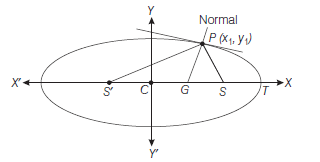
Let \(P\) be any point on the ellipse
\(
\frac{x^2}{a^2}+\frac{y^2}{b^2}=1
\)
\(\therefore\) Equation of normals \(P G\) is
\(
\left(x-x_1\right) \frac{a^2}{x_1}=\left(y-y_1\right) \frac{b^2}{y_1}
\)
Putting \(y=0\). For the point \(G\), we have
\(
\begin{aligned}
& \left(x-x_1\right) \frac{a^2}{x_1}=-b^2 \\
& \therefore x=C G=\left(\frac{a^2-b^2}{a^2}\right) x_1=\frac{a^2 e^2}{a^2} x_1=e^2 x_1 \\
& \therefore \quad S G=C S-C G=a e-e^2 x_1=e\left(a-e x_1\right) \\
& =e S P \\
& \text { Similarly } S^{\prime} G=e S^{\prime} P \\
& \therefore \quad \frac{S G}{S^{\prime} G}=\frac{e S P}{e S^{\prime} P}=\frac{S P}{S^{\prime} P} \\
&
\end{aligned}
\)
\(\therefore\) The normal \(P G\) bisects the internal \(\angle S P S^{\prime}\) between the focal distances but tangent and normal are at right angles, the tangent \(P T\) bisects the external angle SPL between them.
Property 2: The locus of the feet of the perpendiculars from the foci on any tangent to an ellipse is the auxiliary circle. The equation of any tangent in terms slope \((m)\) of the ellipse \(\frac{x^2}{a^2}+\frac{y^2}{b^2}=1\) is
\(
y=m x+\sqrt{\left(a^2 m^2+b^2\right)}
\)
or \(\quad y-m x=\sqrt{\left(a^2 m^2+b^2\right)} \dots(i)\)
Equation of perpendicular line of Eq. (i) and passes through \(( \pm a e, 0)\) is
\(
m y+x= \pm a e \dots(ii)
\)
The locus of the point of intersection of the line given by Eqs. (i) and (ii) can be obtained by eliminating \(m\) between them, squaring and adding Eqs. (i) and (ii), we get
\(
\begin{aligned}
& y^2\left(1+m^2\right)+x^2\left(1+m^2\right)=a^2 m^2+b^2+a^2 e^2 \\
& \Rightarrow \quad\left(1+m^2\right)\left(x^2+y^2\right)=a^2 m^2+a^2 \\
& =a^2\left(1+m^2\right) \\
& \text { or } \quad x^2+y^2=a^2 \\
&
\end{aligned}
\)
which is the equation of the auxiliary circle of the ellipse \(\frac{x^2}{a^2}+\frac{y^2}{b^2}=1\)
Reflection Property of an Ellipse
If an incoming light ray passes through on focus \((S)\) strike the concave side of the ellipse, then it will get reflected towards other focus \(\left(S^{\prime}\right)\).
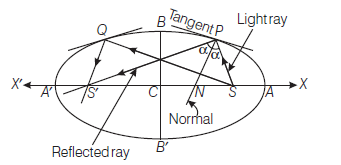
\text { and } \quad \angle S P S^{\prime}=\angle S Q S^{\prime}
\)
Example 47: A ray emanating from the point \((-3,0)\) is incident on the ellipse \(16 x^2+25 y^2=400\) at the point \(P\) with ordinate 4 . Find the equation of the reflected ray after first reflection.
Answer: For point \(P, y\)-coordinate \(=4\)
\(\because\) Given ellipse is \(16 x^2+25 y^2=400\)
\(
16 x^2+25(4)^2=400
\)
Coordinate of \(P\) is \((0,4)\)
\(
\begin{aligned}
e^2 & =1-\frac{16}{25}=\frac{9}{25} \\
e & =\frac{3}{5}
\end{aligned}
\)

foci \(( \pm a e, 0)\) i.e. \(( \pm 3,0)\)
Equation of reflected ray (i.e. PS) is
\(
\frac{x}{3}+\frac{y}{4}=1 \text { or } 4 x+3 y=12 .
\)
Equation of an Ellipse Referred to Two Perpendicular Lines
Let \(P(x, y)\) be any point on the ellipse \(\frac{x^2}{a^2}+\frac{y^2}{b^2}=1\) then,
\(
\begin{aligned}
& y=P M, x=P N \\
& \therefore \quad \frac{(P N)^2}{a^2}+\frac{(P M)^2}{b^2}=1 \\
&
\end{aligned}
\)
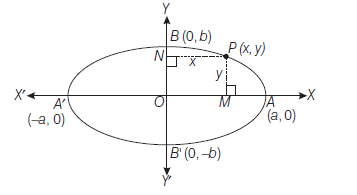
suppose if axes along the lines
\(
\begin{gathered}
a_1 x+b_1 y+c_1=0 \text { and } b_1 x-a_1 y+c_2=0 \\
\text { then } P N=\frac{\left|a_1 x+b_1 y+c_1\right|}{\sqrt{\left(a_1^2+b_1^2\right)}} \\
P M=\frac{\left|b_1 x-a_1 y+c_2\right|}{\sqrt{\left(b_1^2+a_1^2\right)}}
\end{gathered}
\)
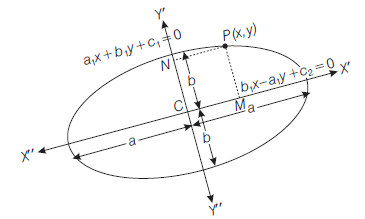
then, equation of ellipse is
\(
\frac{\left\{\frac{a_1 x+b_1 y+c_1}{\sqrt{\left(a_1^2+b_1^2\right)}}\right\}^2}{a^2}+\frac{\left\{\frac{b_1 x-a_1 y+c_2}{\sqrt{\left(b_1^2+a_1^2\right)}}\right\}^2}{b^2}=1
\)
Centre :
- Is the point of intersection of \(a_1 x+b_1 y+c_1=0\) and \(b_1 x-a_1 y+c_2=0\)
Equations of Major and Minor Axes :
- If \(a>b\), then major axis lies along \(b_1 x-a_1 y+c_2=0\) and minor axis lies along \(a_1 x+b_1 y+c_1=0\).
- If \(a<b\), then major axis lies along \(a_1 x+b_1 y+c_1=0\) and minor axis lies along \(b_1 x-a_1 y+c_2=0\)
Eccentricity:
- If \(a>b, b^2=a^2\left(1-e^2\right)\)
- If \(a<b, a^2=b^2\left(1-e^2\right)\)
Foci :
- If \(a>b\)
\(
\frac{a_1 x+b_1 y+c_1}{\sqrt{\left(a_1^2+b_1^2\right)}}= \pm a e, \frac{b_1 x-a_1 y+c_2}{\sqrt{\left(b_1^2+a_1^2\right.}}=0
\)
we get after solving \((x, y)\) - If \(a<b\)
\(\frac{a_1 x+b_1 y+c_1}{\sqrt{a_1^2+b_1^2}}=0, \frac{b_1 x-a_1 y+c_2}{\sqrt{b_1^2+a_1^2}}= \pm b e\)
we get after solving \((x, y)\)
Directrices :
- If \(a>b\),
\(
\frac{a_1 x+b_1 y+c_1}{\sqrt{\left(a_1^2+b_1^2\right)}}= \pm \frac{a}{e}
\) - If \(a<b\),
\(
\frac{b_1 x-a_1 y+c_2}{\sqrt{\left(a_1^2+b_1^2\right)}}= \pm \frac{b}{e}
\)
Example 48: Determine the equations of major and minor axes of the ellipse
\(
4(x-2 y+1)^2+9(2 x+y+2)^2=25
\)
Also, find its centre, length of the latusrectum and eccentricity.
Answer: The equation of the ellipse can be written as
\(
4 \times 5\left(\frac{x-2 y+1}{\sqrt{5}}\right)^2+9 \times 5\left(\frac{2 x+y+2}{\sqrt{5}}\right)^2=25
\)
\(
\text { or } \frac{\left(\frac{x-2 y+1}{\sqrt{5}}\right)^2}{(5 / 4)}+\frac{\left(\frac{2 x+y+2}{\sqrt{5}}\right)^2}{(5 / 9)}=1
\)
\(
\text { or } \quad \frac{X^2}{a^2}+\frac{Y^2}{b^2}=1
\)
Here \(a>b\)
\(\therefore\) Equation of major axis is \(Y=0\)
i.e. \(2 x+y+2=0\)
and Equation of minor axis is \(X=0\)
i.e. \(\quad x-2 y+1=0\)
Centre: \(X=0, Y=0\)
\(\Rightarrow \quad x-2 y+1=0,2 x+y+2=0\)
we get \(\quad x=-1, y=0\)
\(\therefore\) Centre is \((-1,0)\)
Length of latusrectum \(=\frac{2 b^2}{a}=\frac{2 \times 5 / 9}{5 / 4}=\frac{8}{9}\)
Eccentricity:
\(
b^2=a^2\left(1-e^2\right)
\)
\(
\begin{aligned}
& \Rightarrow \quad \frac{5}{9}=\frac{5}{4}\left(1-e^2\right) \\
& \Rightarrow \quad \frac{4}{9}=1-e^2 \\
& \Rightarrow \quad e^2=\frac{5}{9} \\
& \therefore \quad e=\frac{\sqrt{5}}{3} \\
&
\end{aligned}
\)
Example 49: A rod \(AB\) of length \(15 cm\) rests in between two coordinate axes in such a way that the end point A lies on \(x\)-axis and end point \(B\) lies on \(y\)-axis. A point \(P (x, y)\) is taken on the rod in such a way that \(A P=6 cm\). Show that the locus of \(P\) is an ellipse.
Answer:

Let \(A B\) be the rod making an angle \(\theta\) with \(OX\) as shown in Fig 10.33 and \(P (x, y)\) the point on it such that \(A P=6 cm\).
Since
\(
\begin{aligned}
& AB =15 cm , \text { we have } \\
& PB =9 cm .
\end{aligned}
\)
From \(P\) draw \(PQ\) and \(PR\) perpendiculars on \(y\)-axis and \(x\)-axis, respectively.
From \(\quad \triangle PBQ , \cos \theta=\frac{x}{9}\)
From \(\triangle PRA , \sin \theta=\frac{y}{6}\)
Since \(\cos ^2 \theta+\sin ^2 \theta=1\)
\(
\left(\frac{x}{9}\right)^2+\left(\frac{y}{6}\right)^2=1
\)
\(
\text { or } \quad \frac{x^2}{81}+\frac{y^2}{36}=1
\)
Thus the locus of \(P\) is an ellipse.